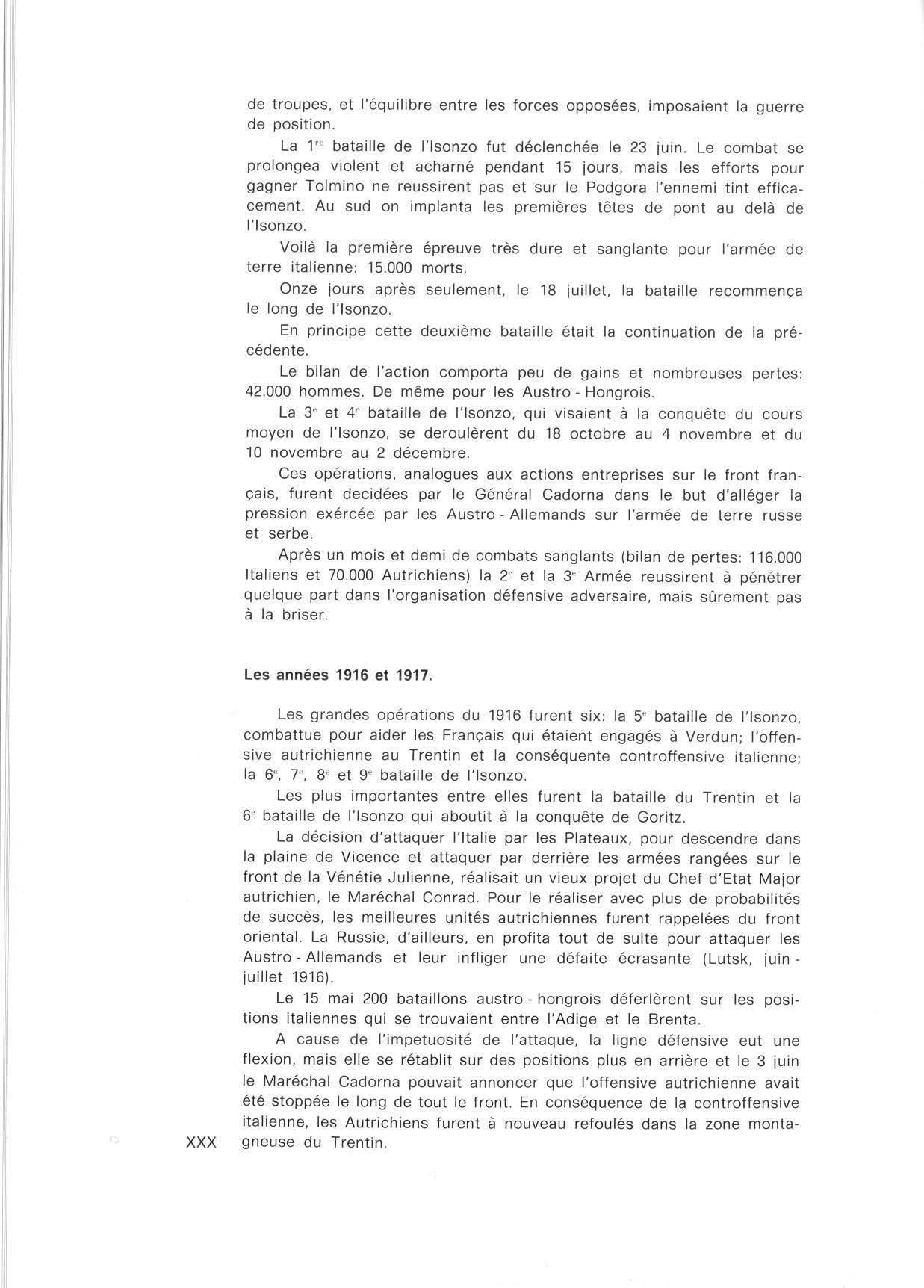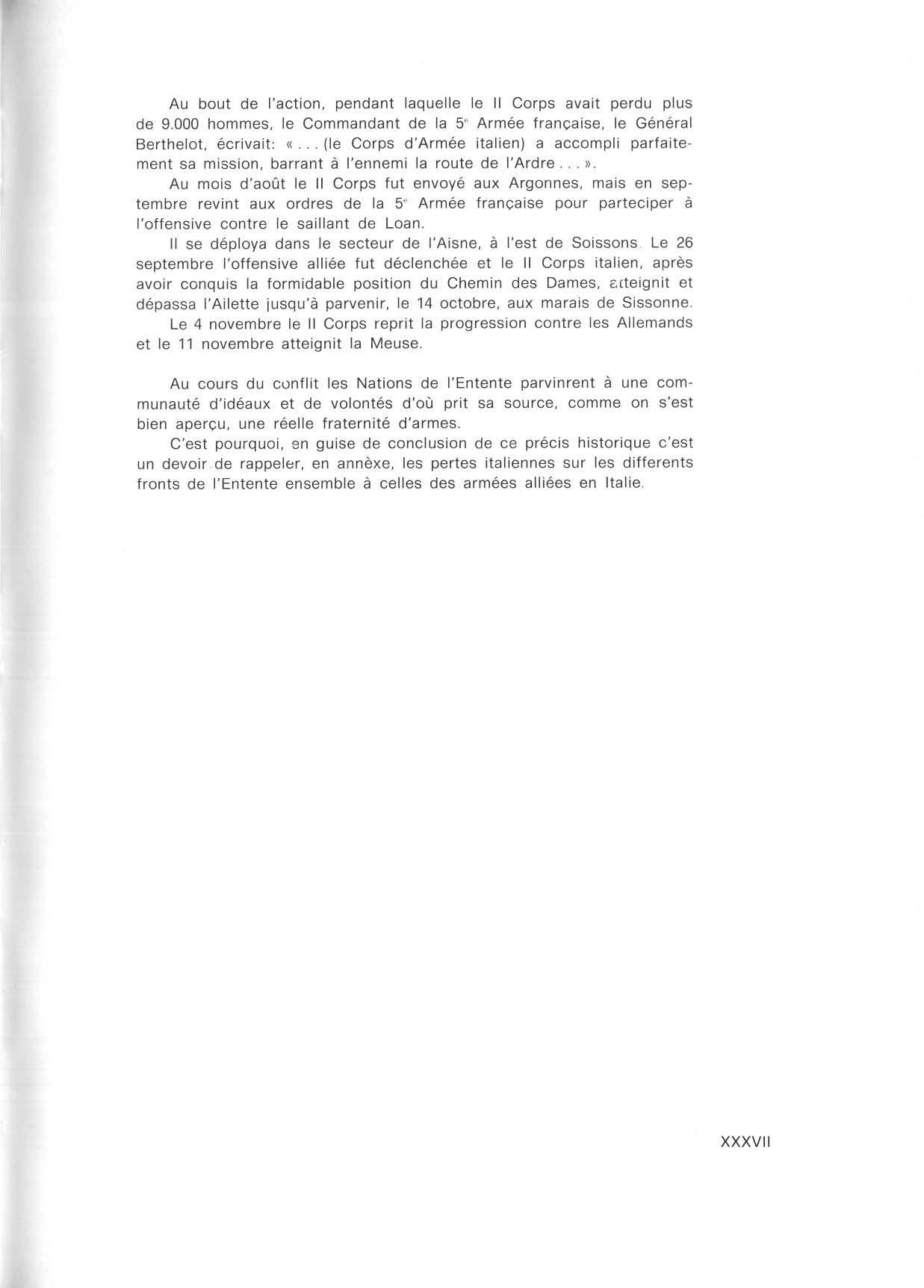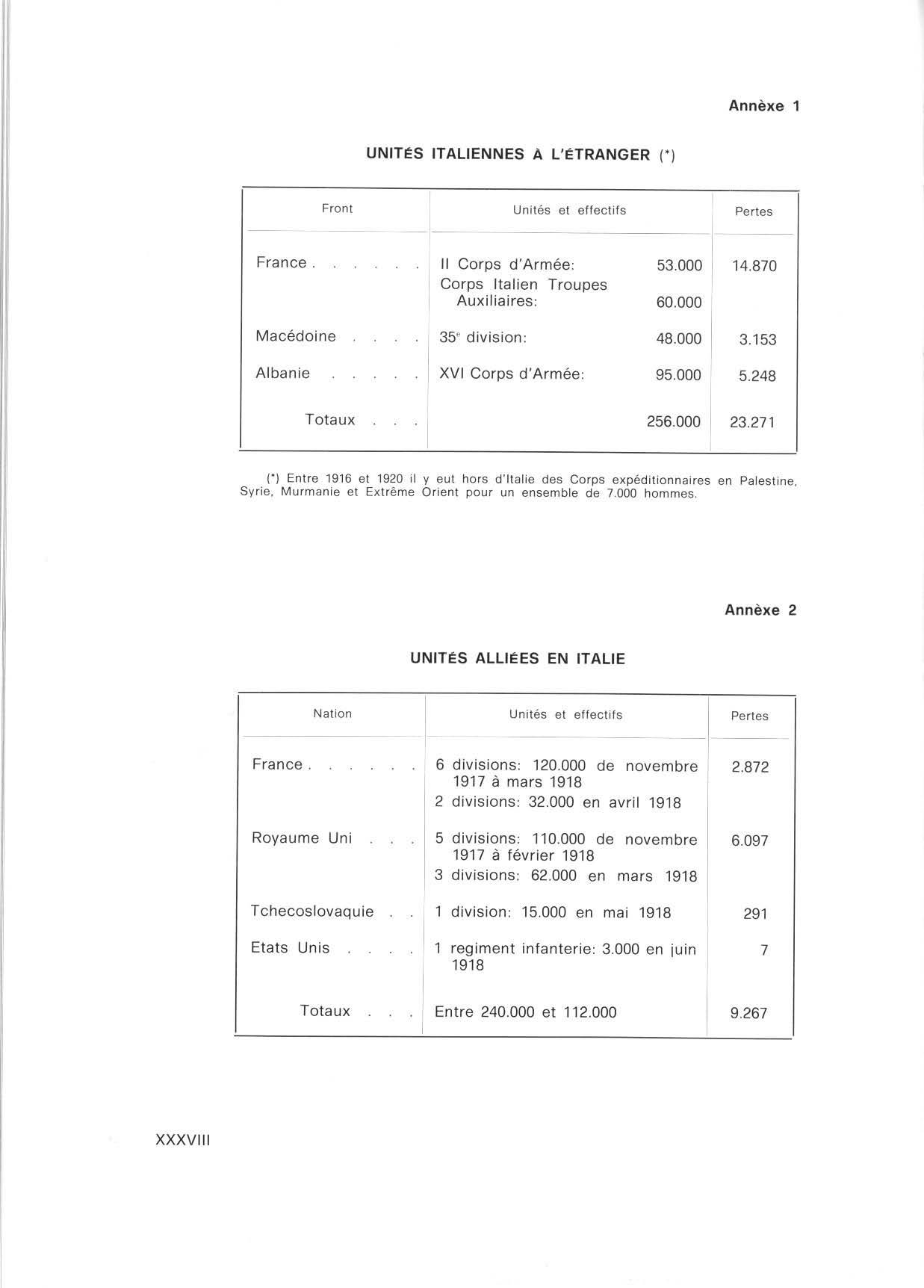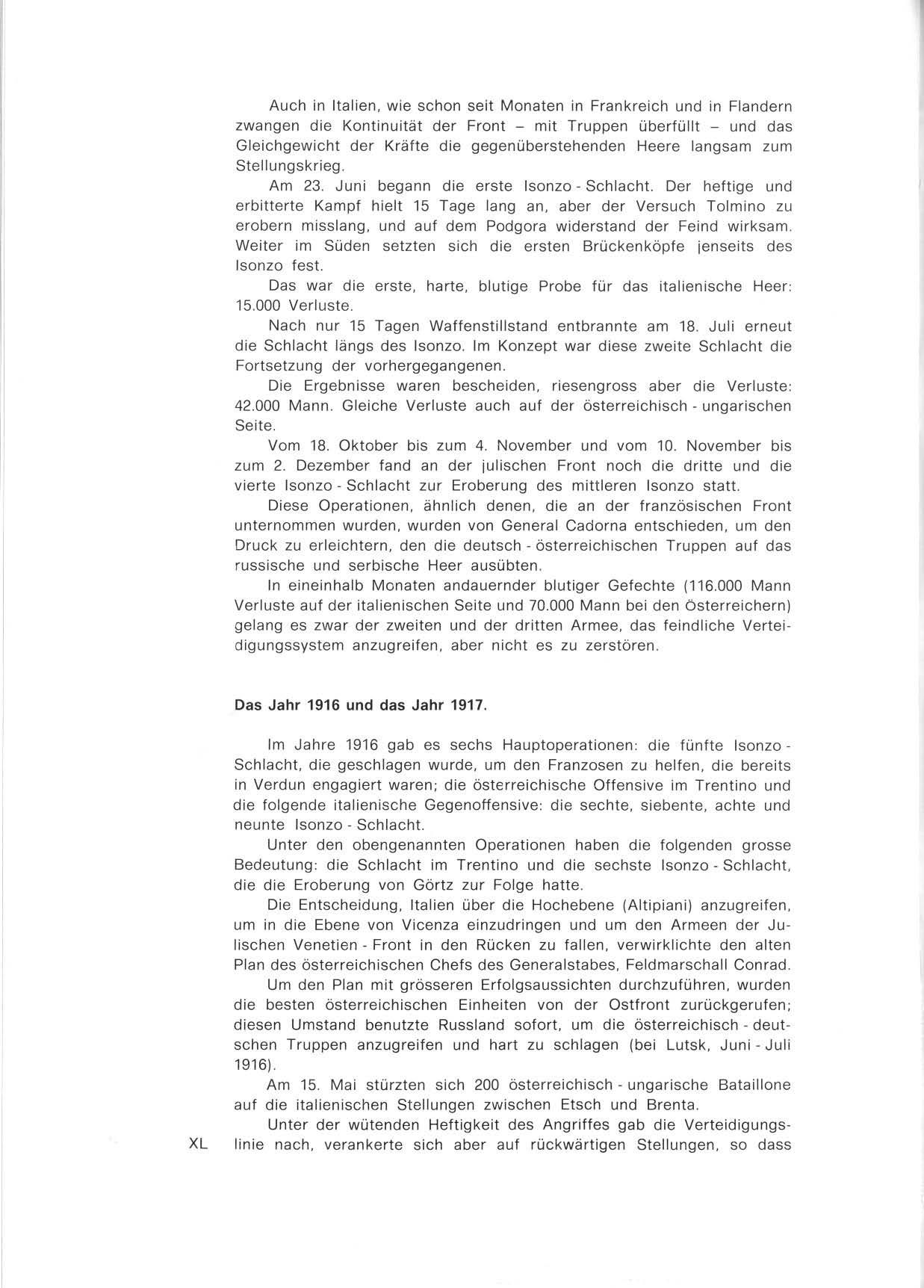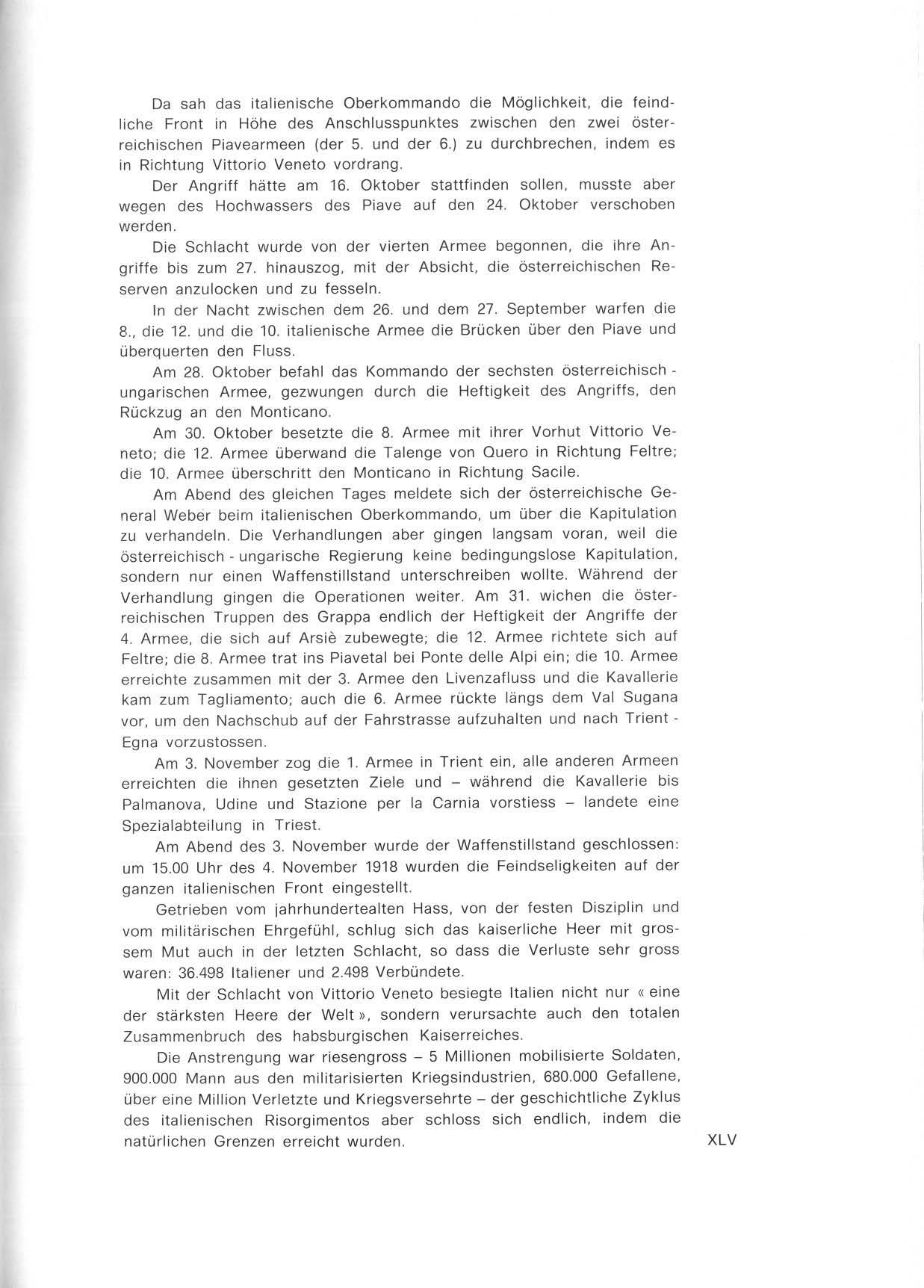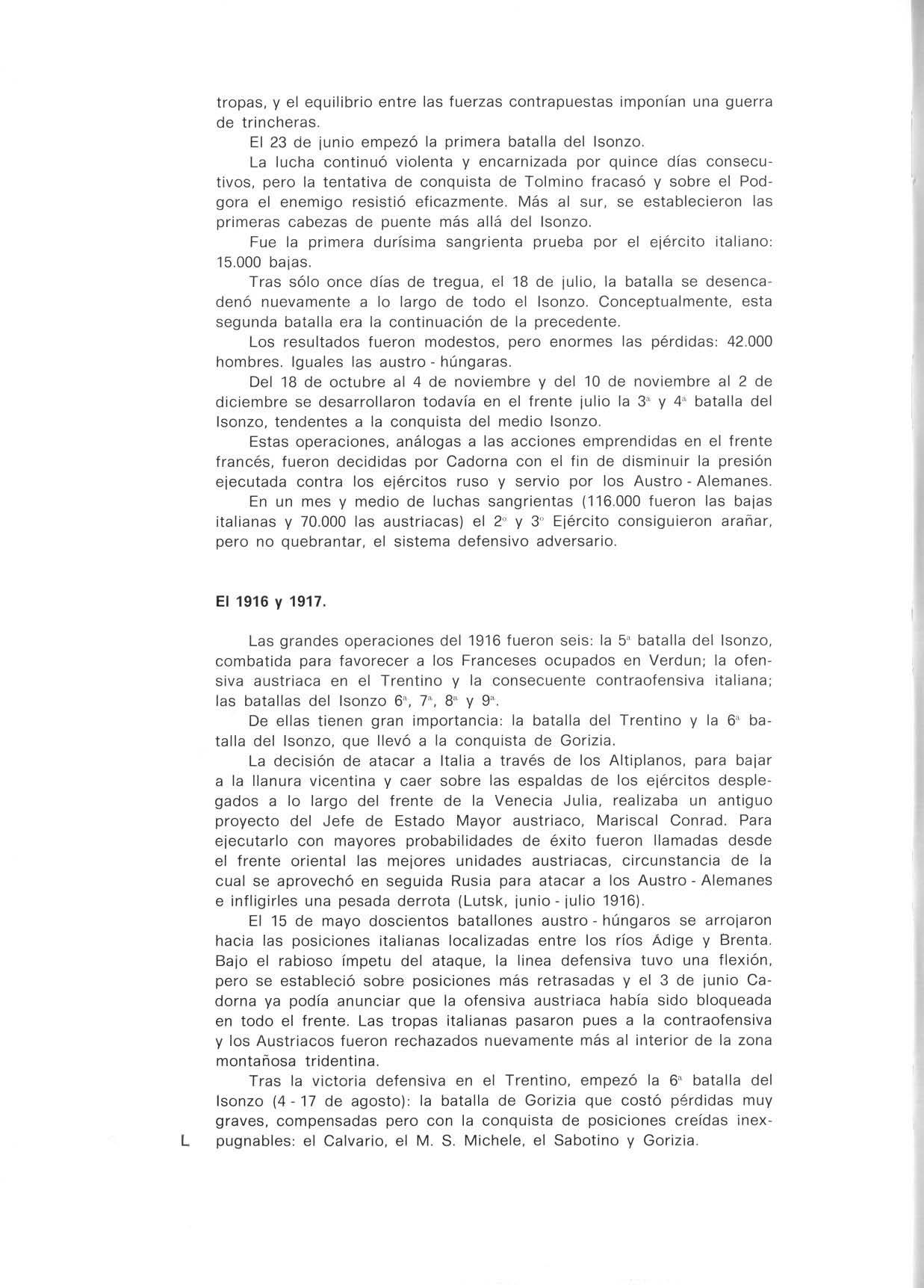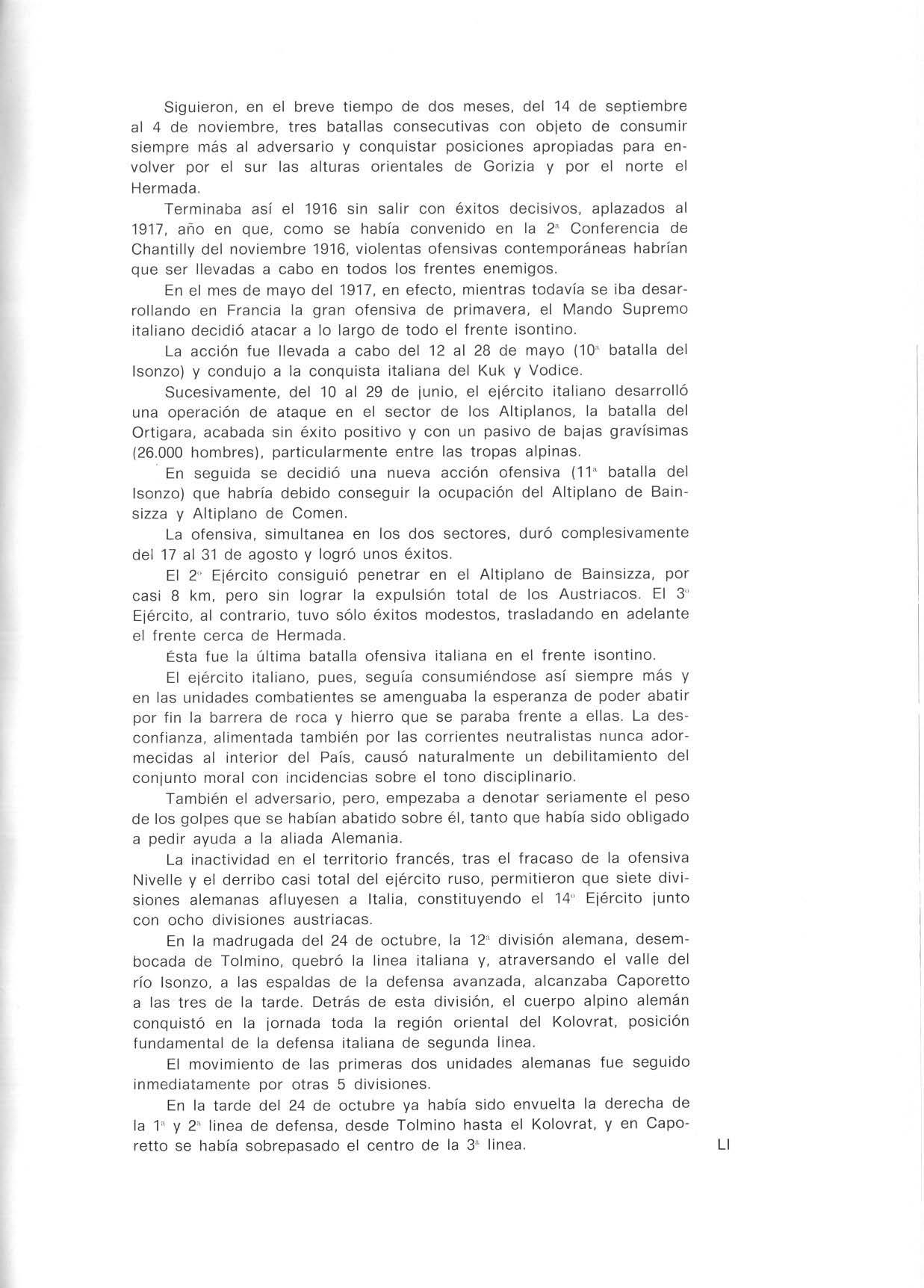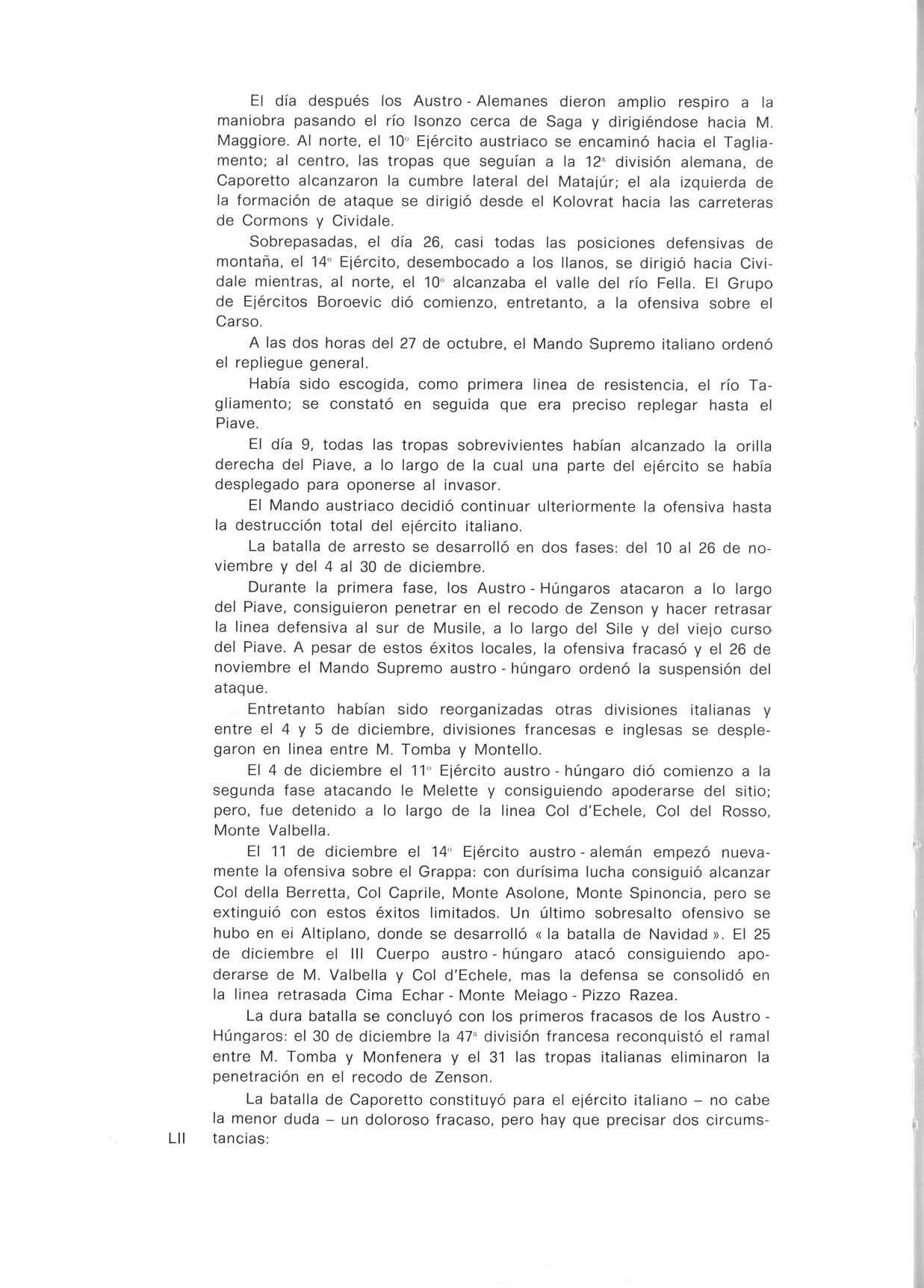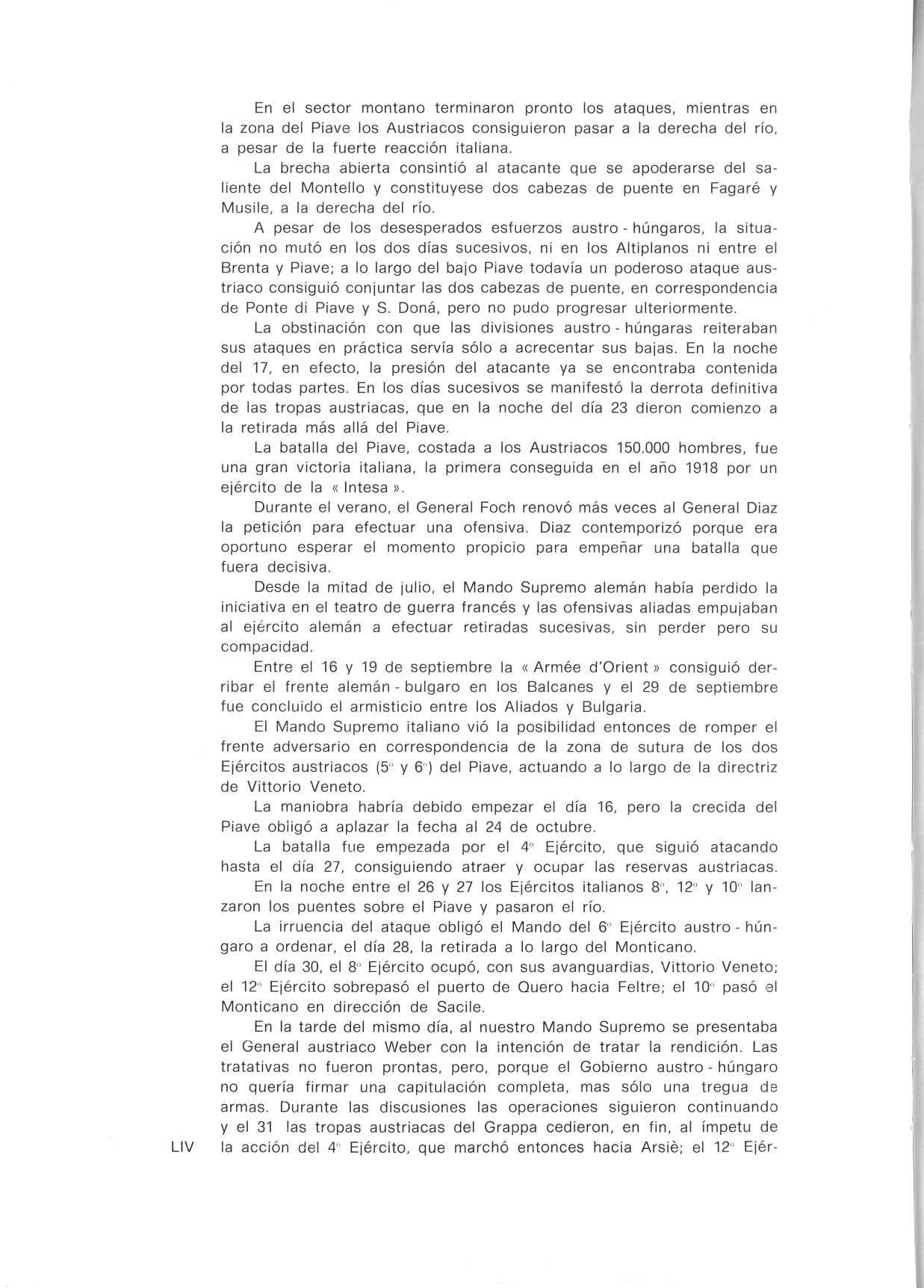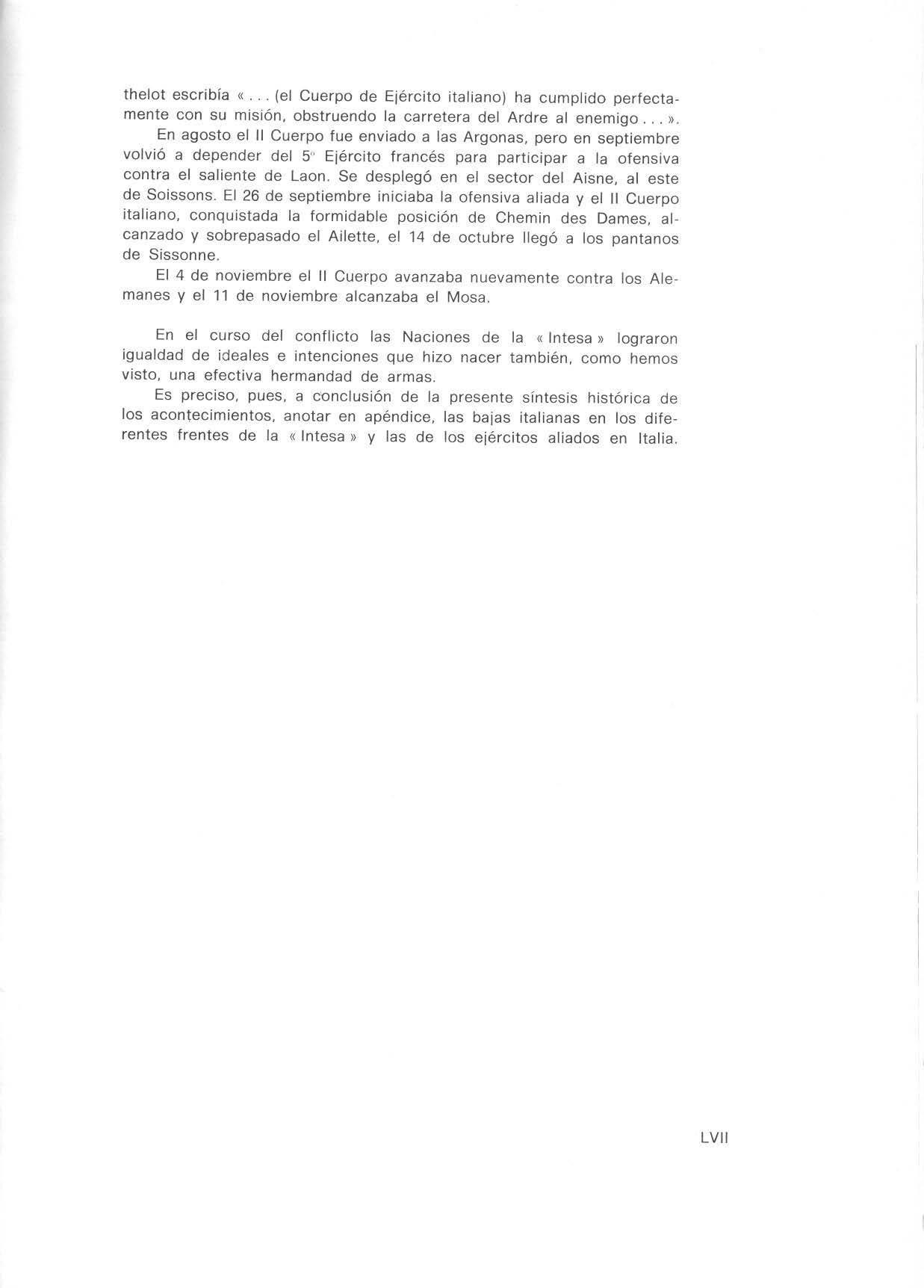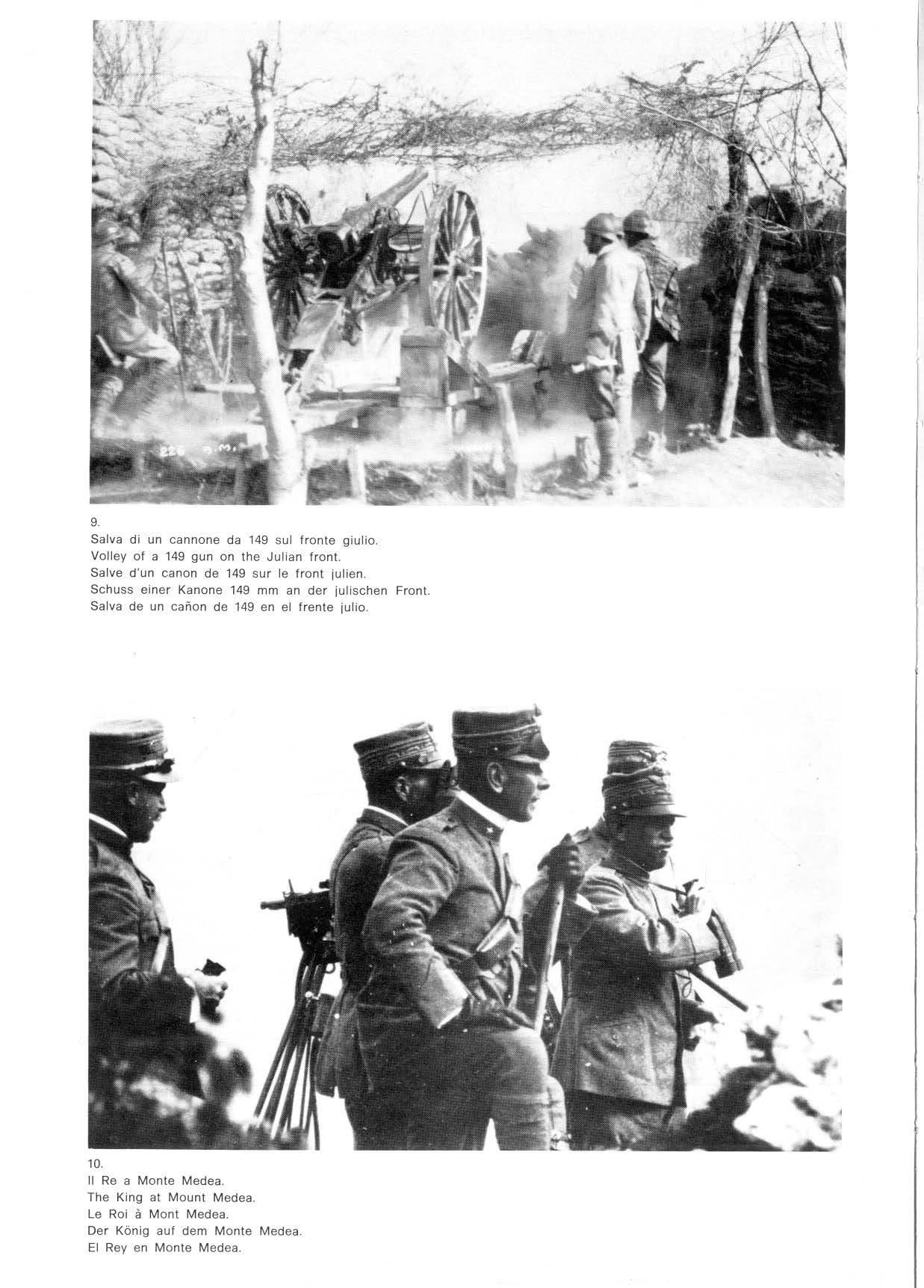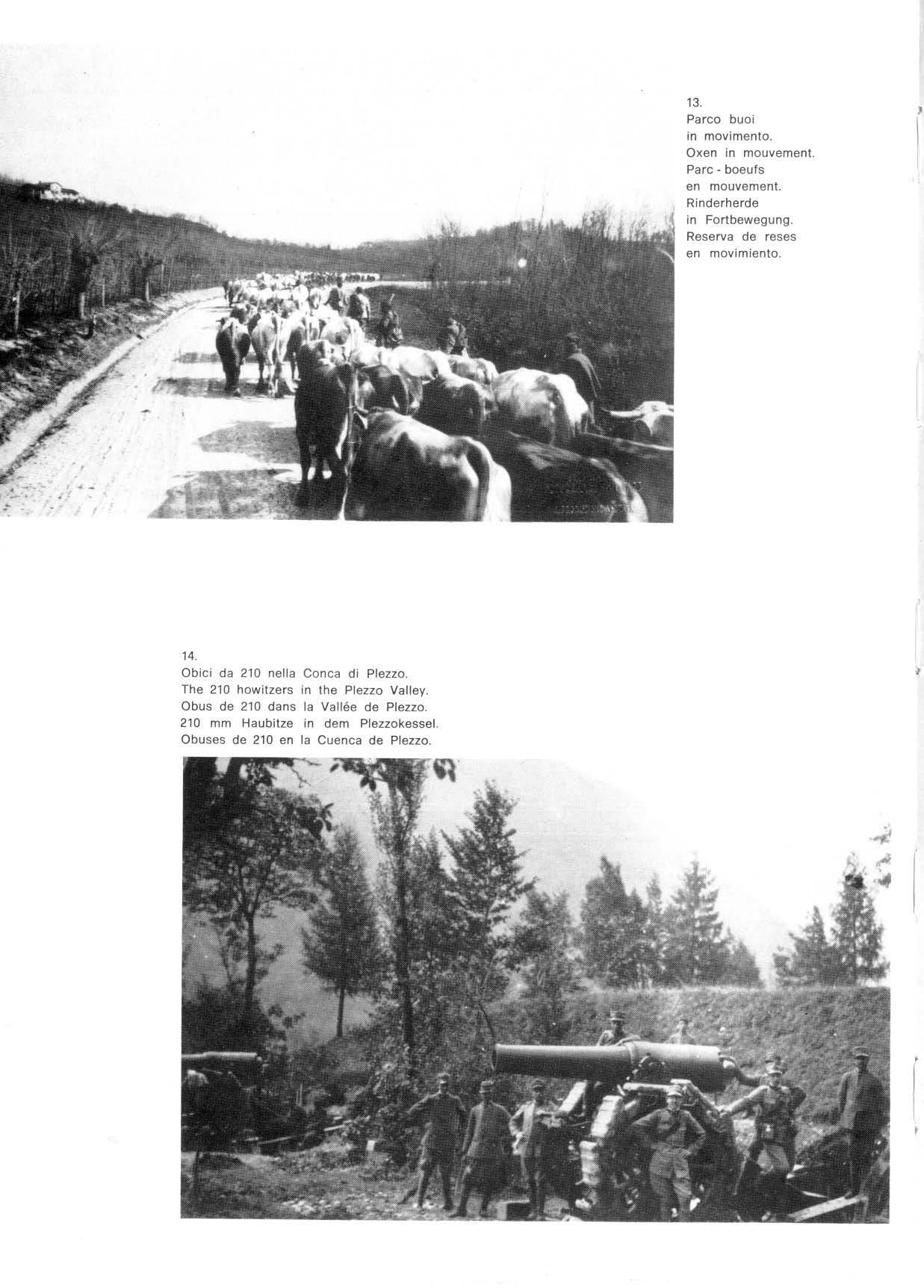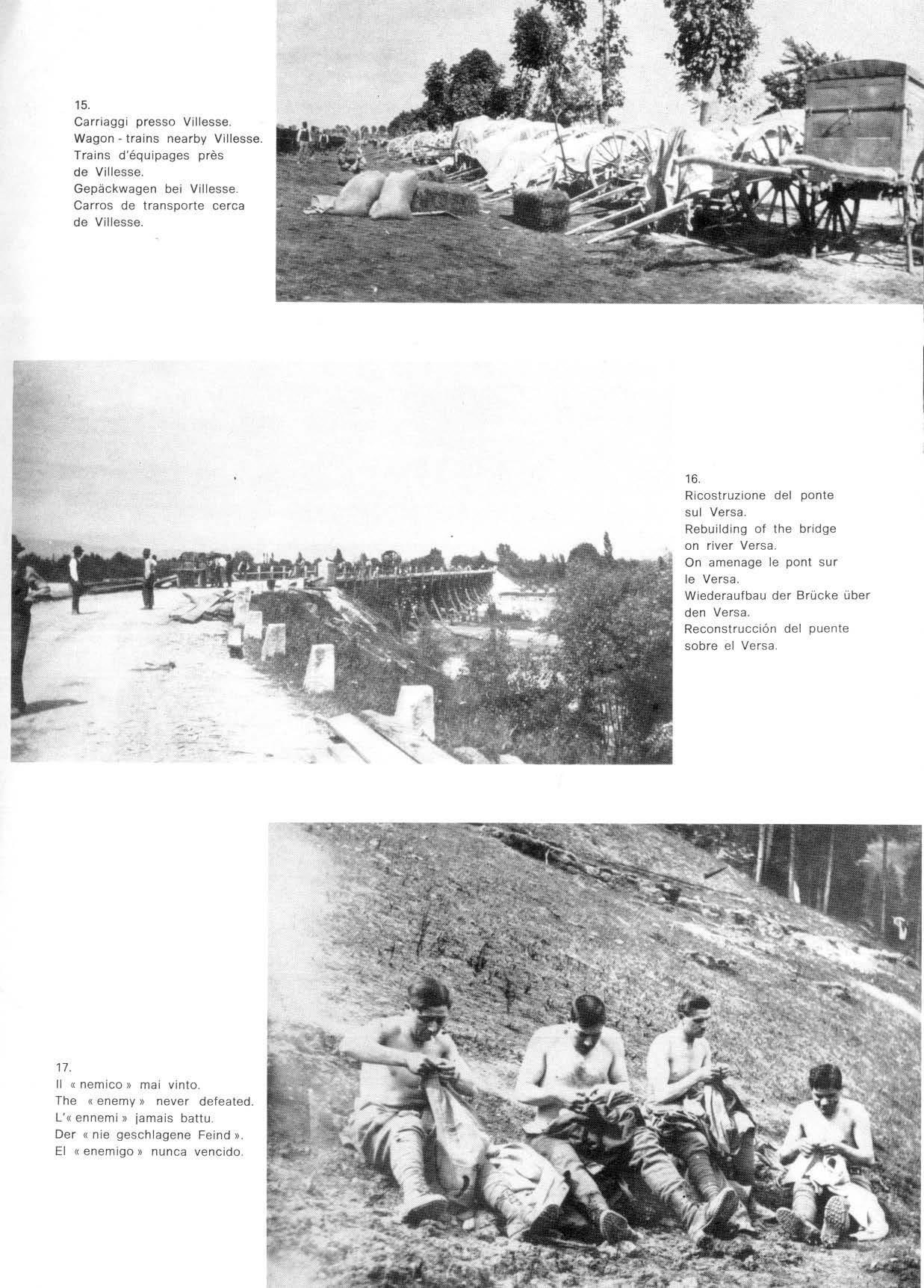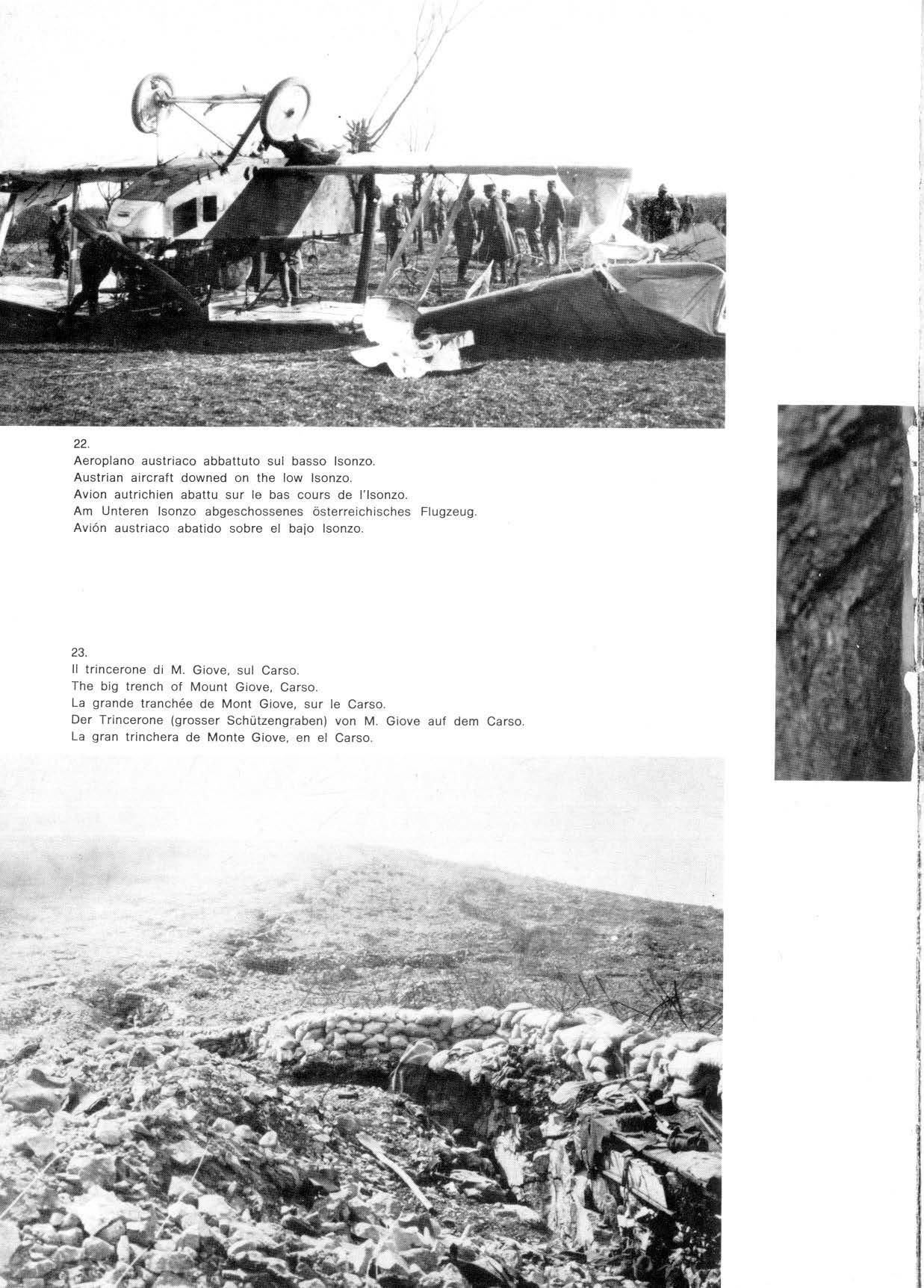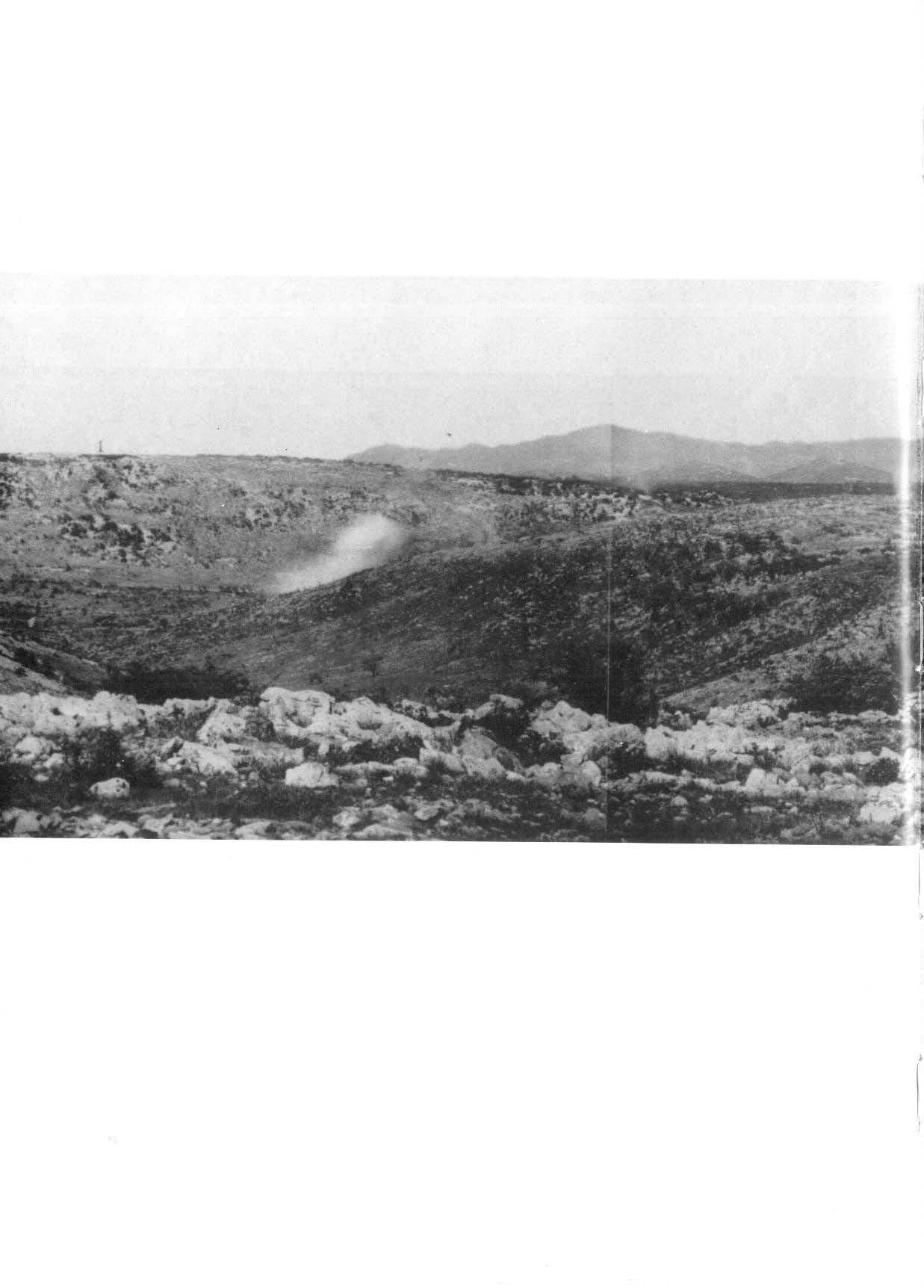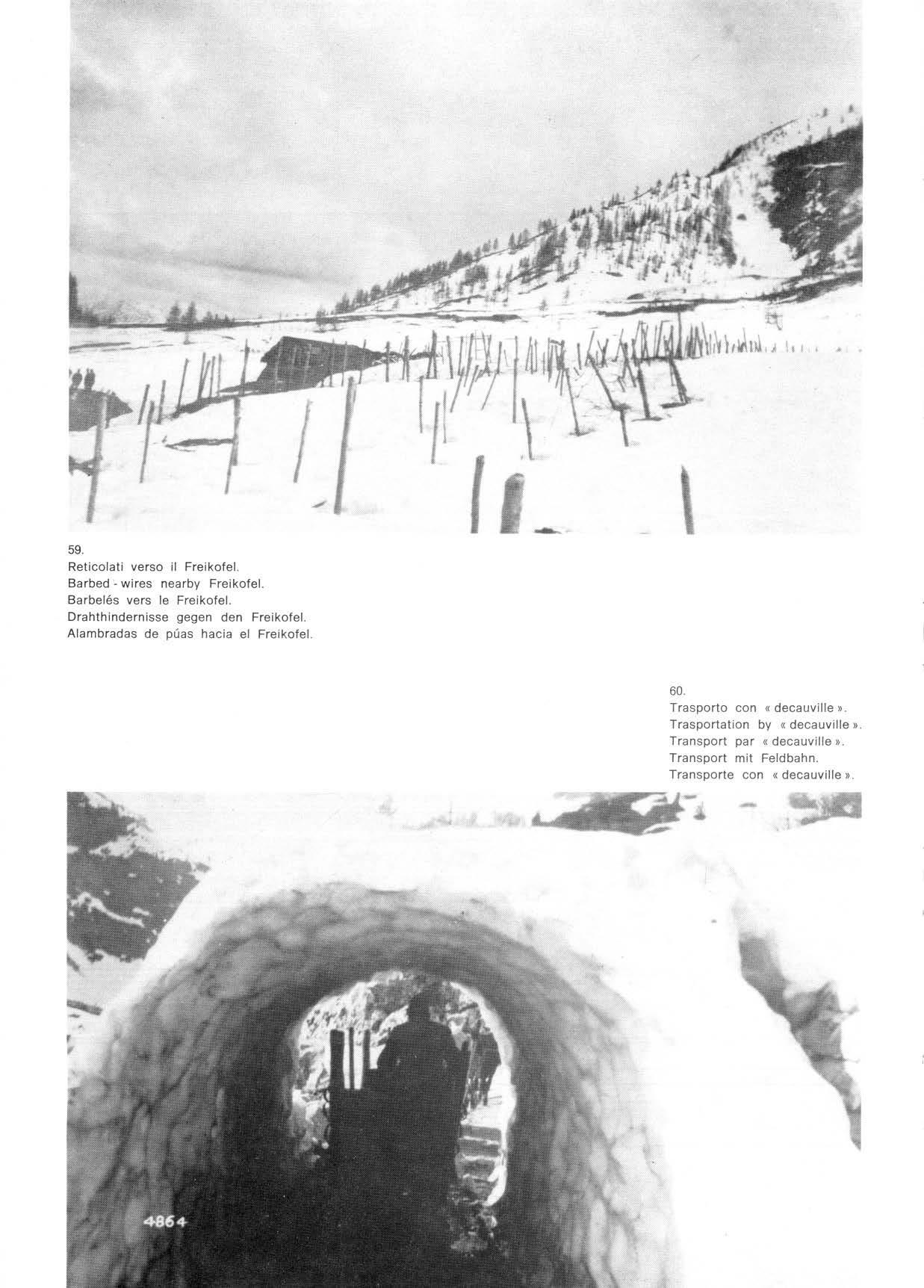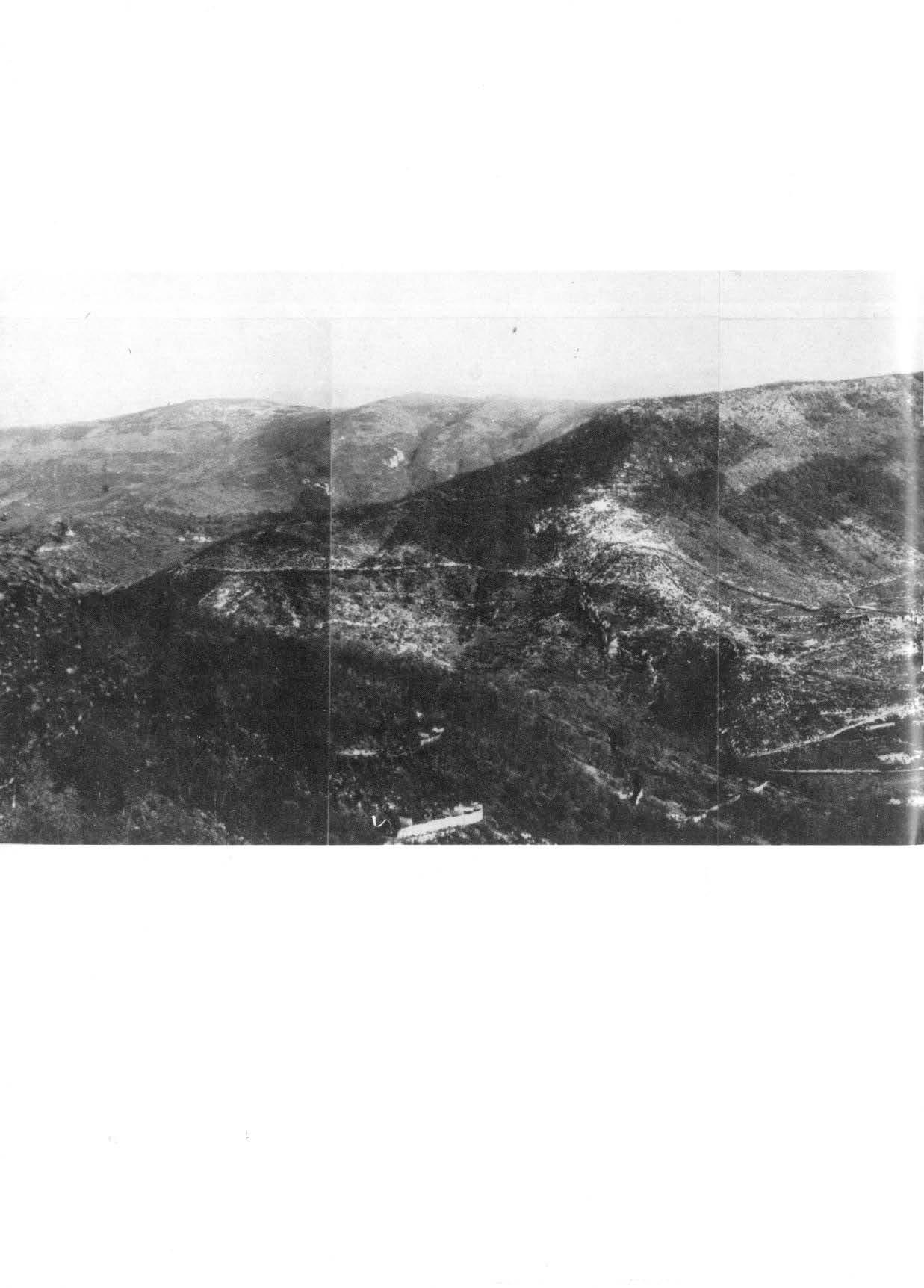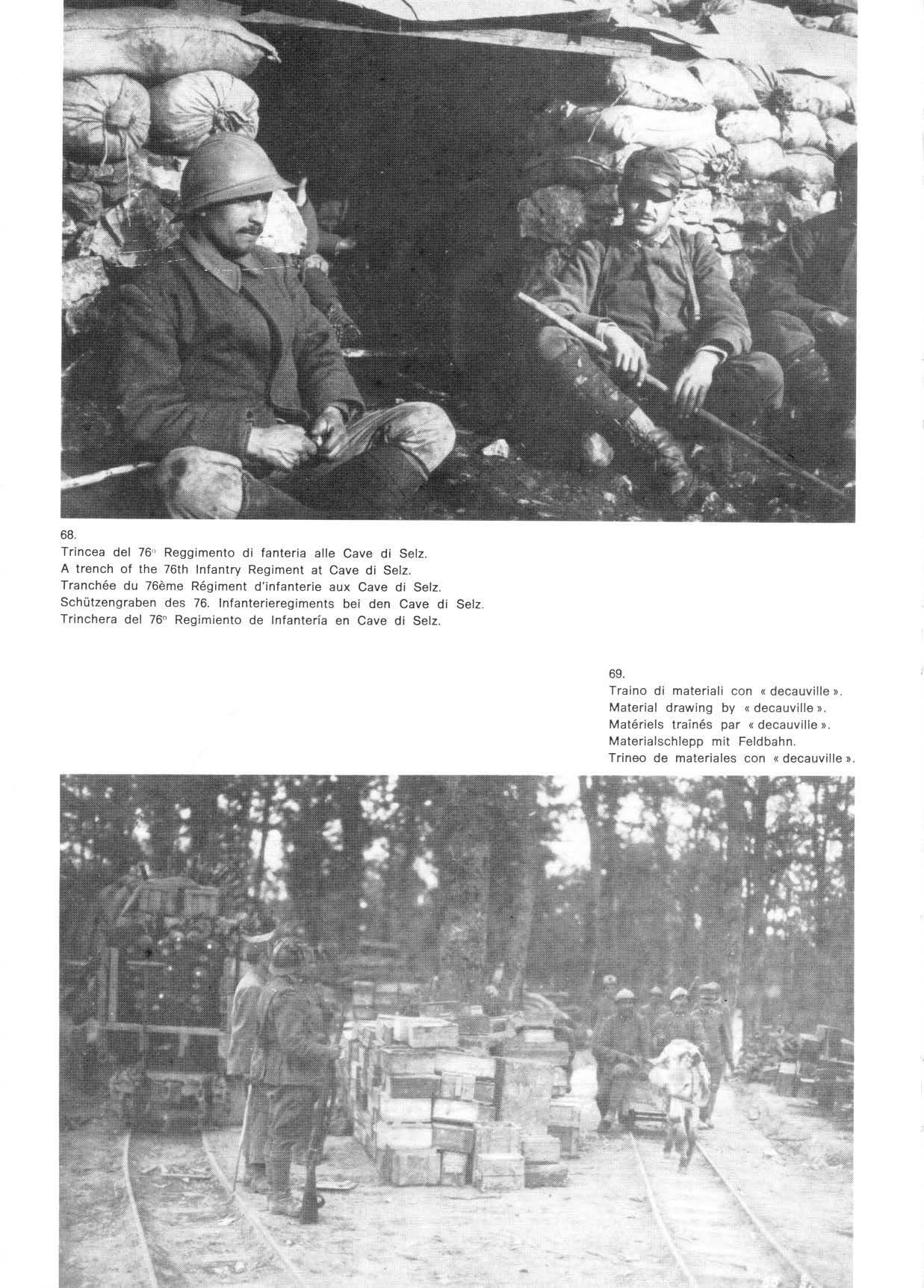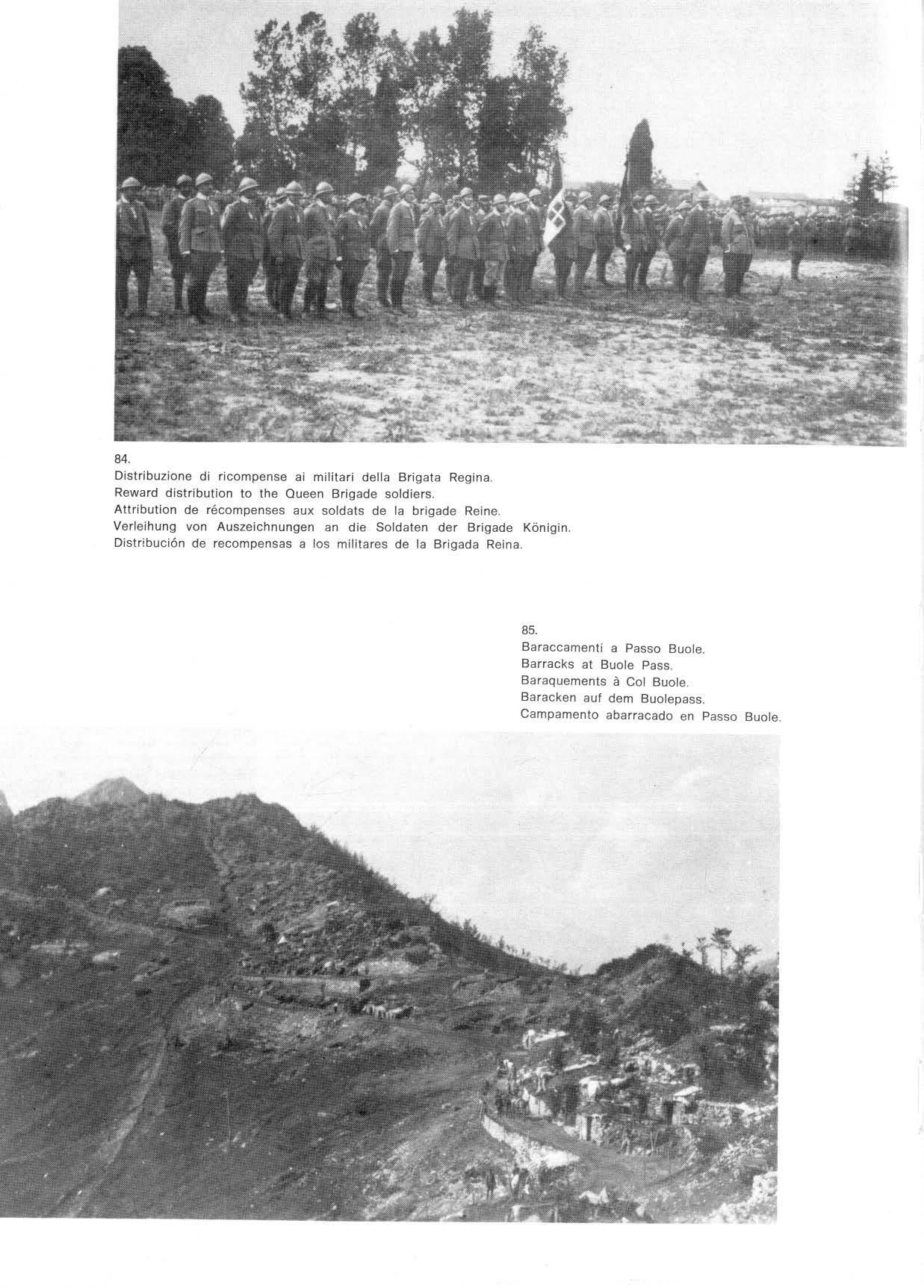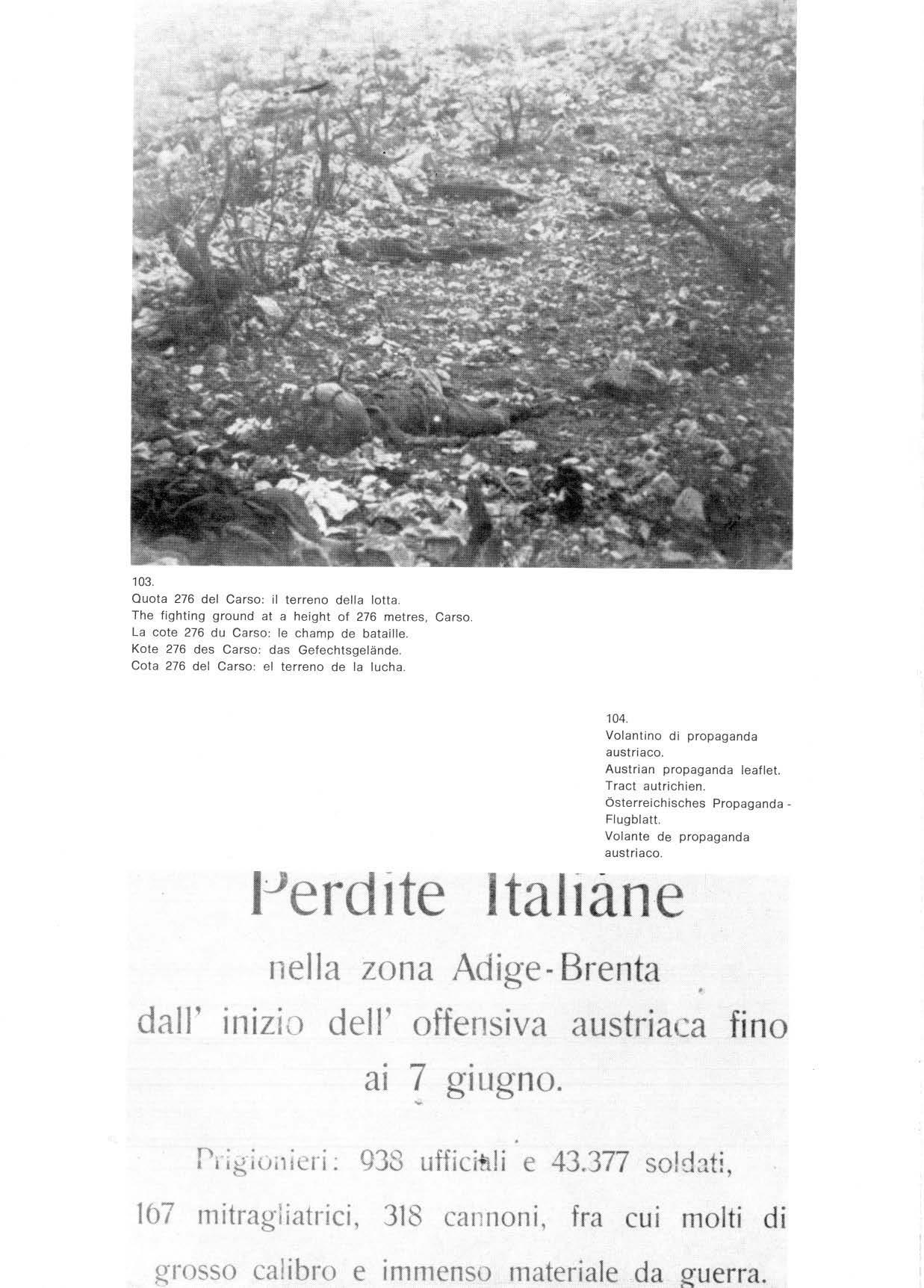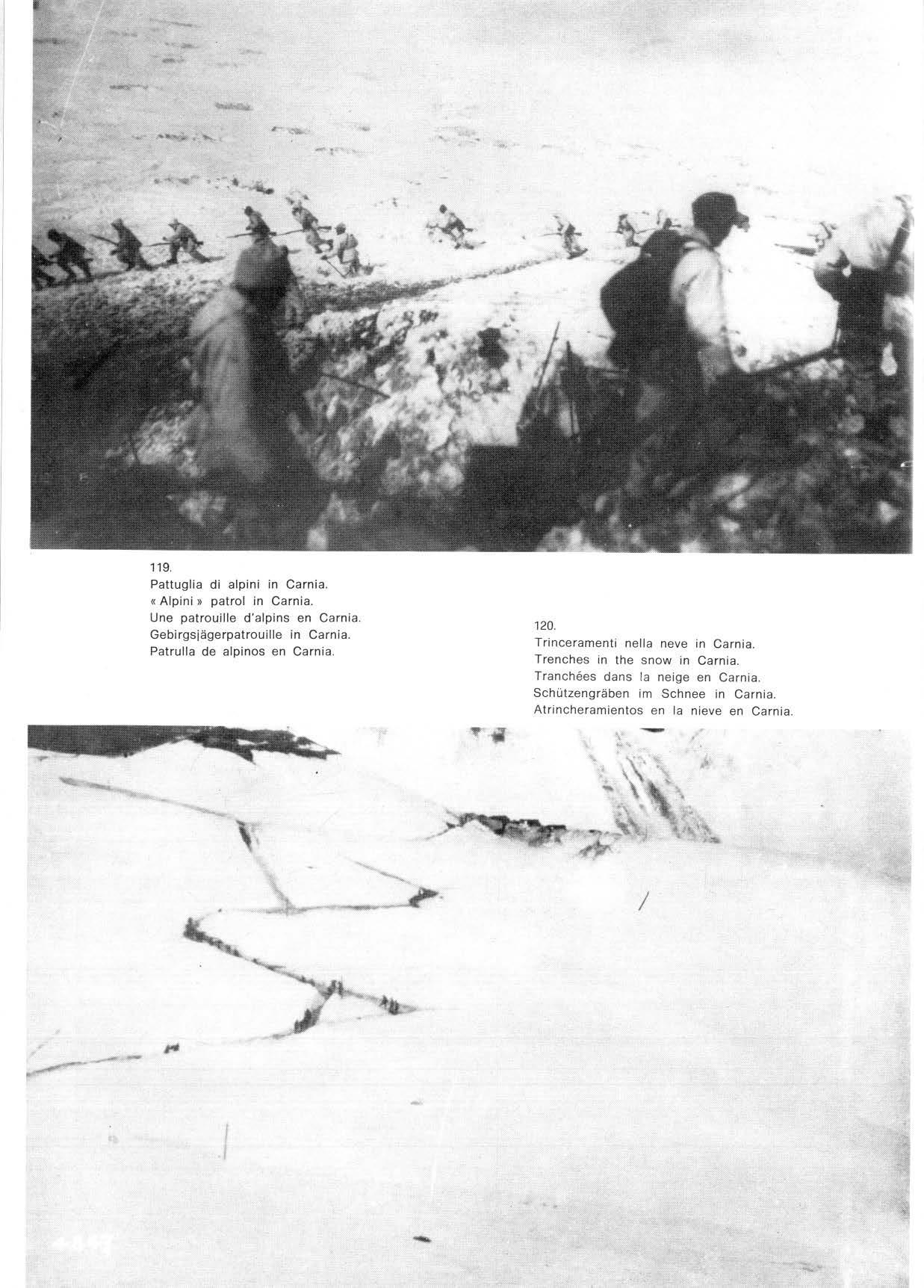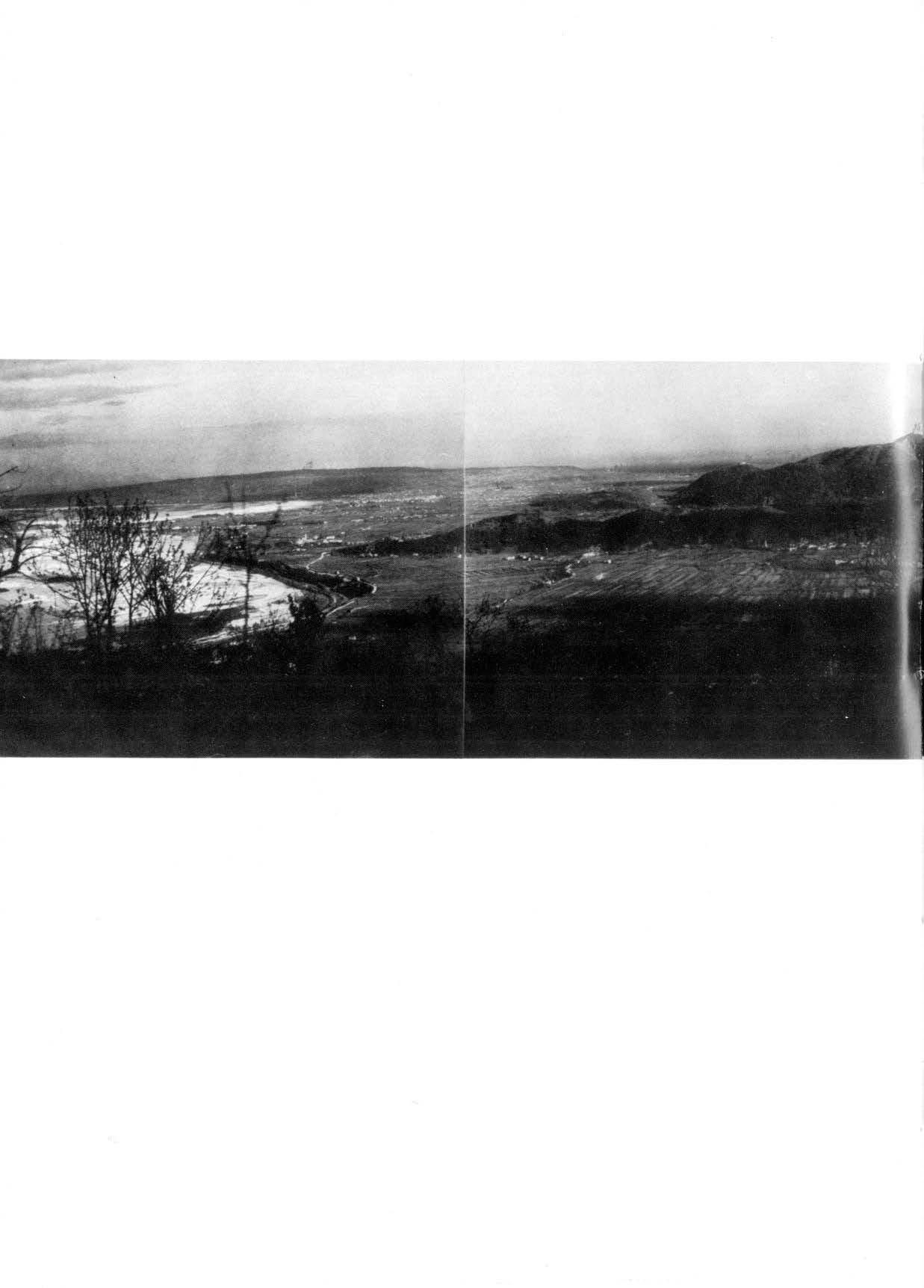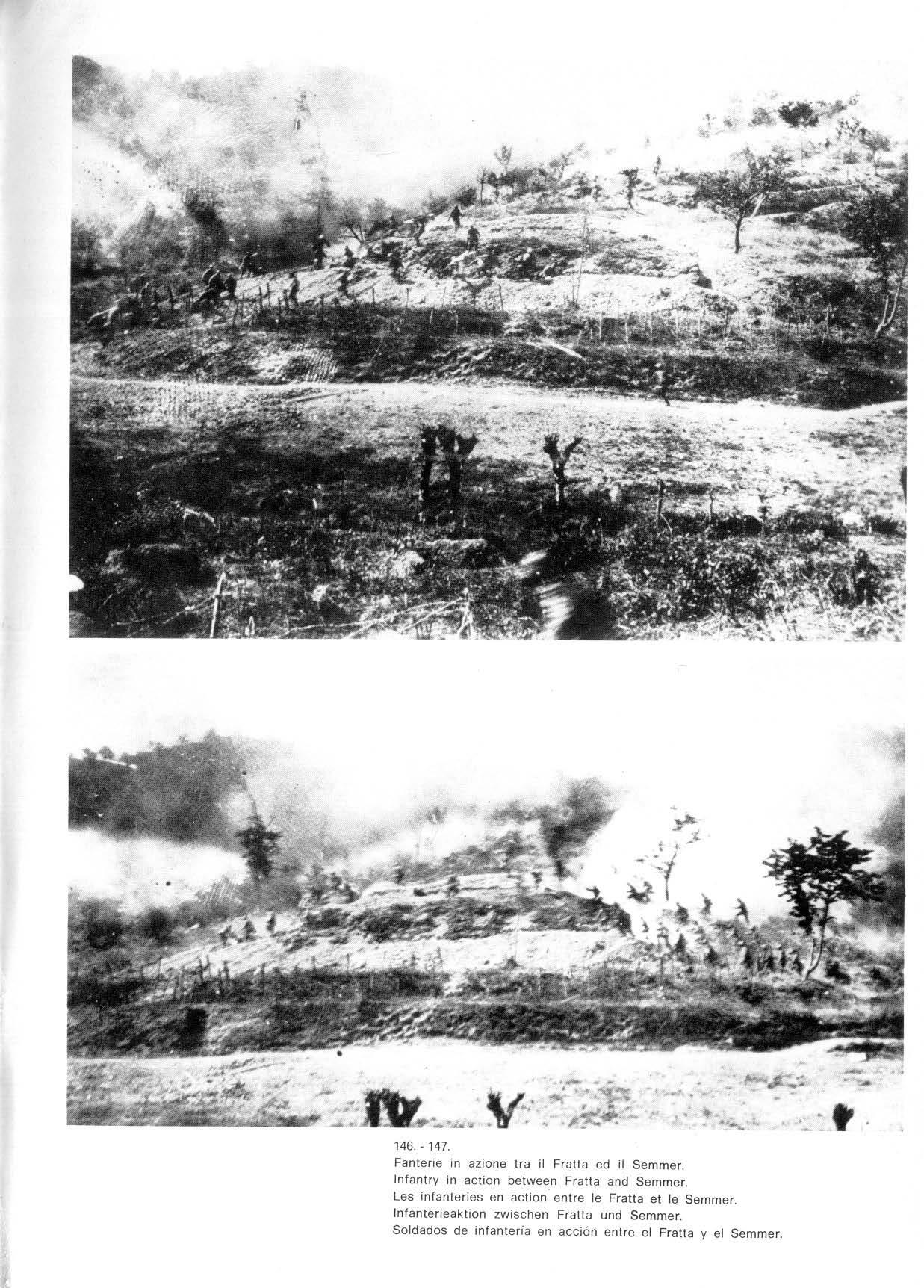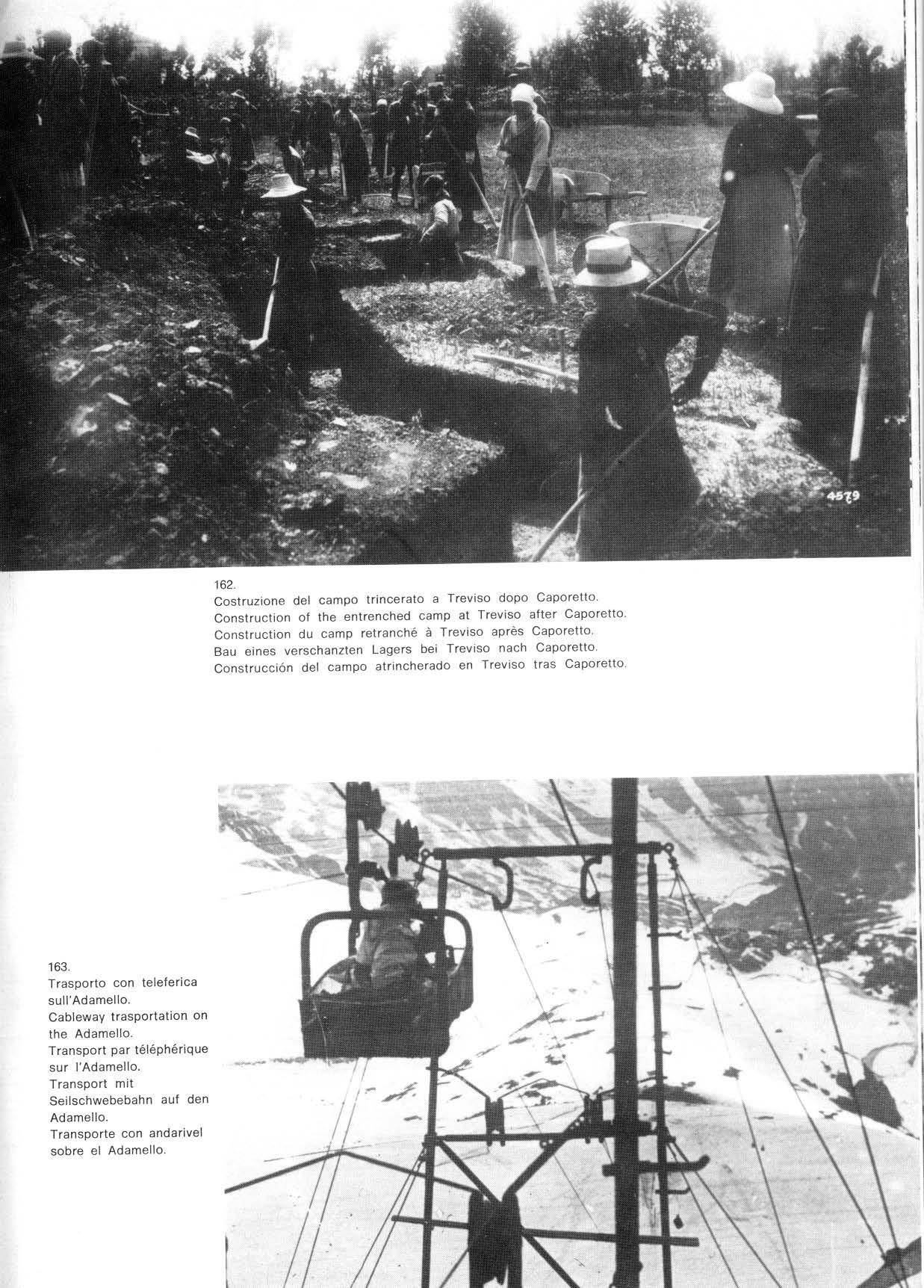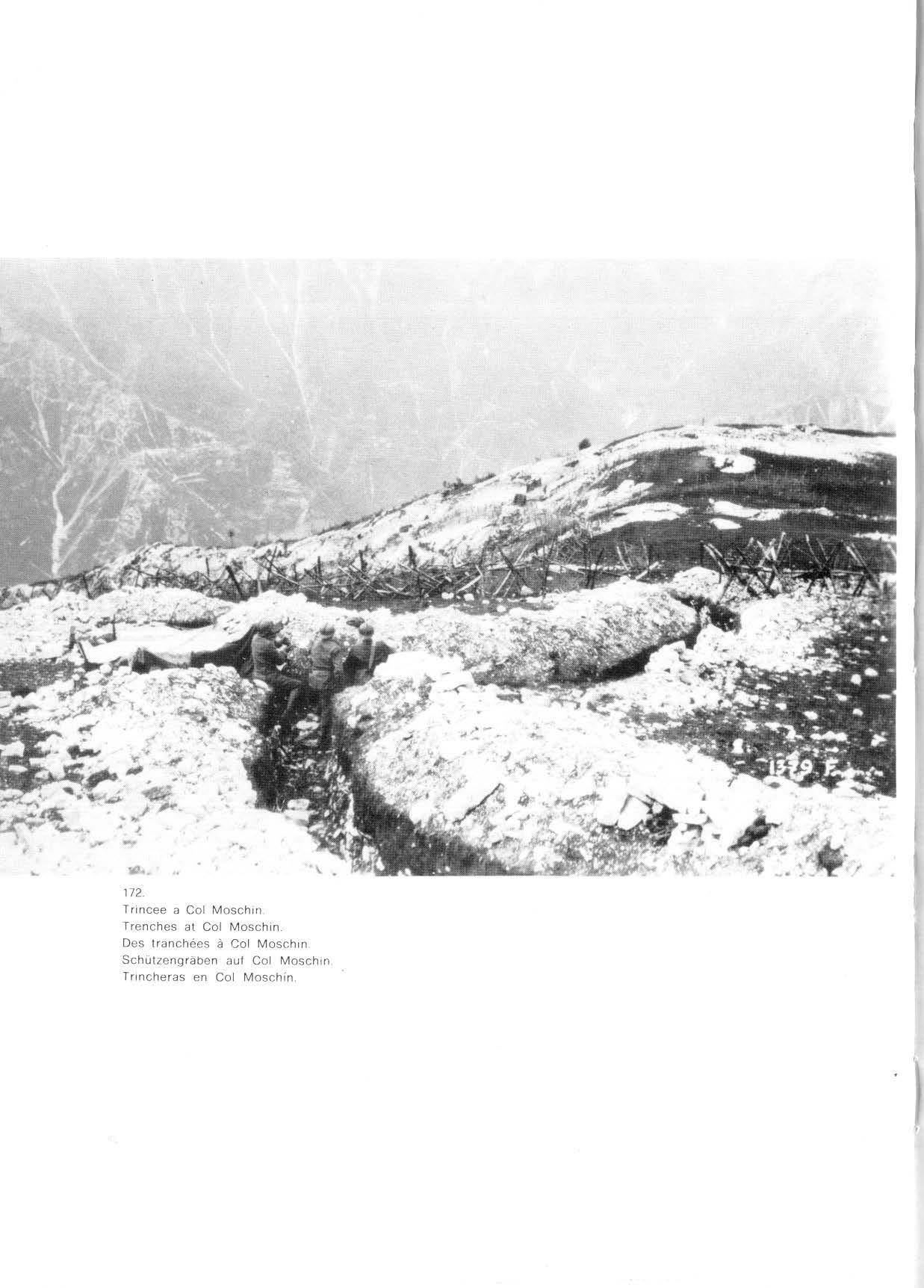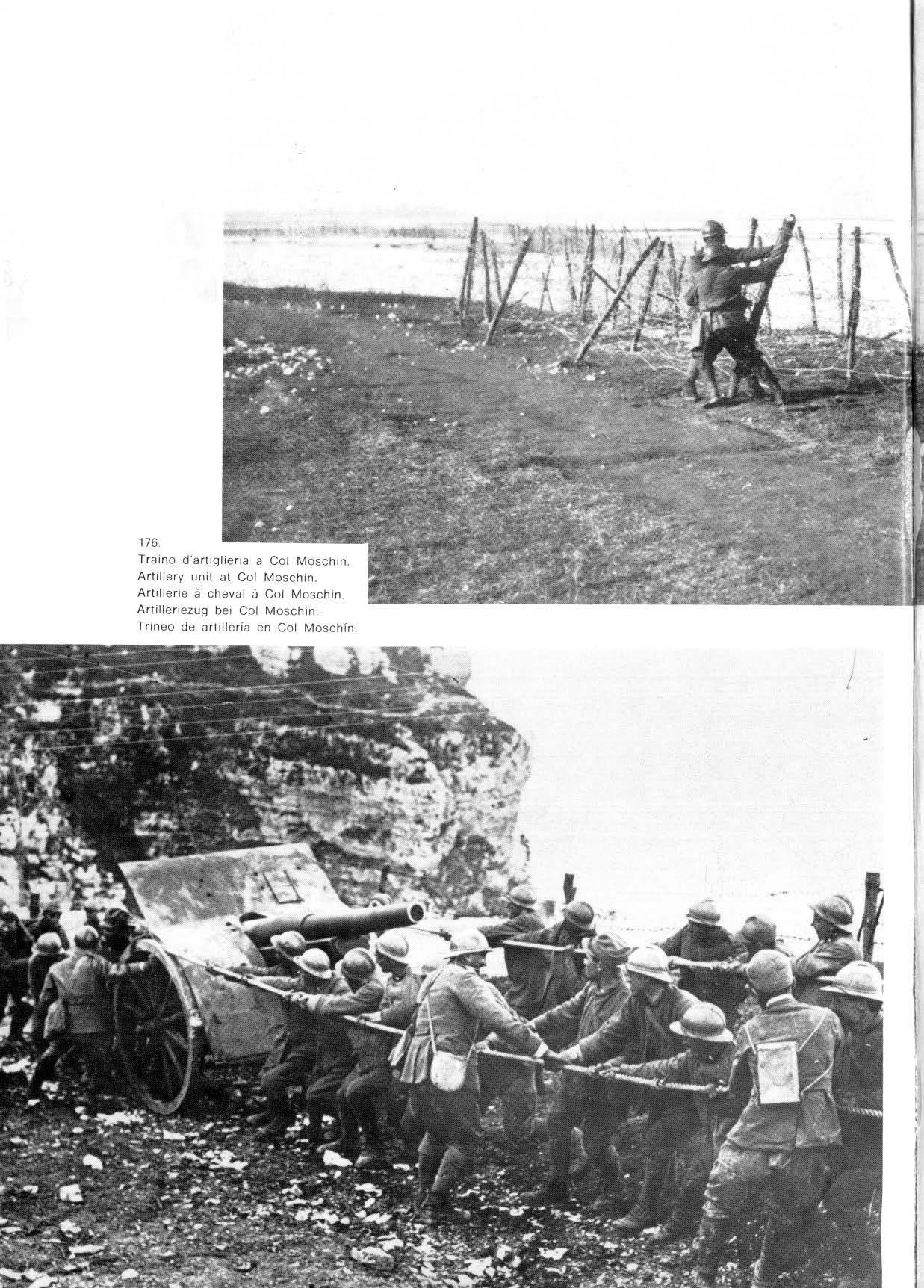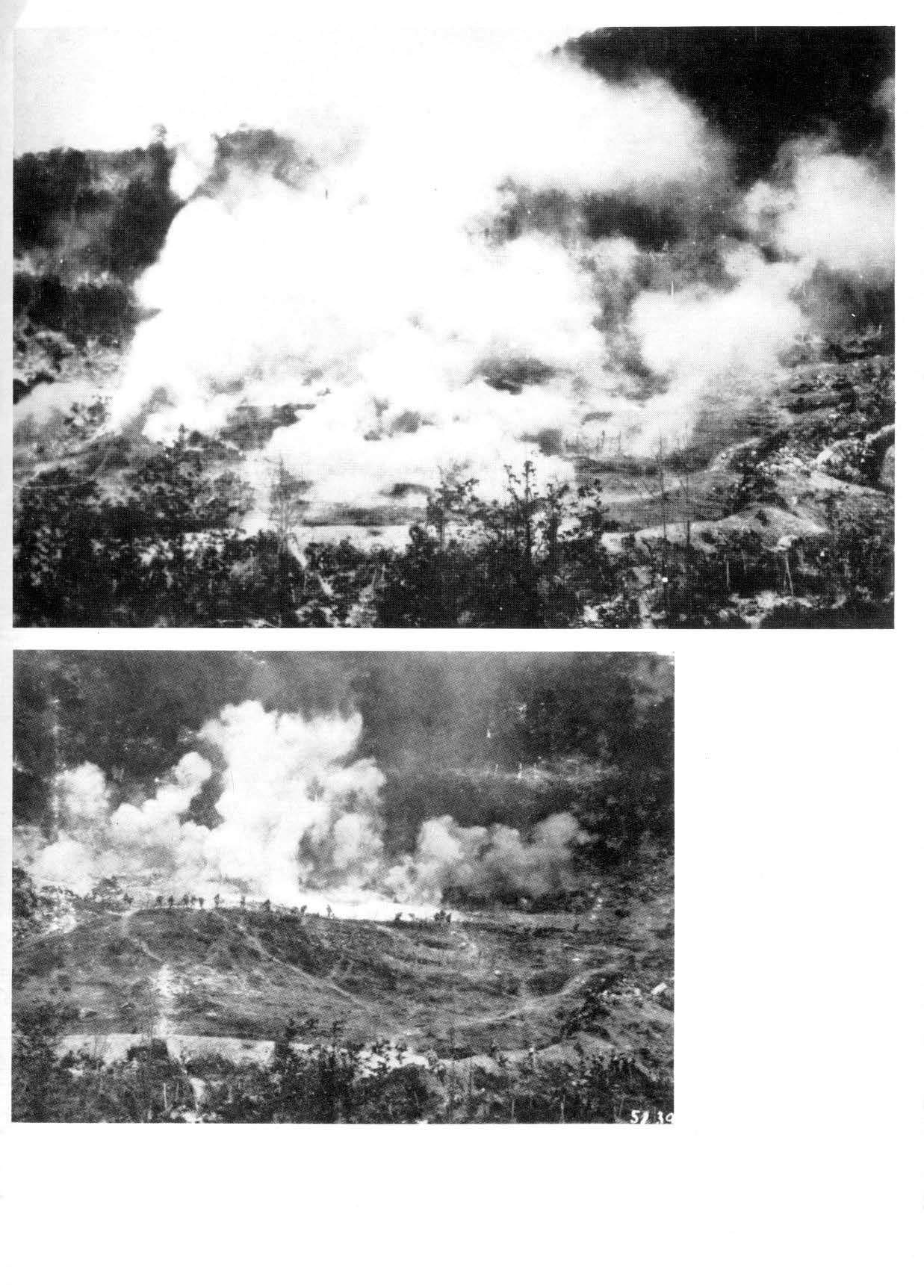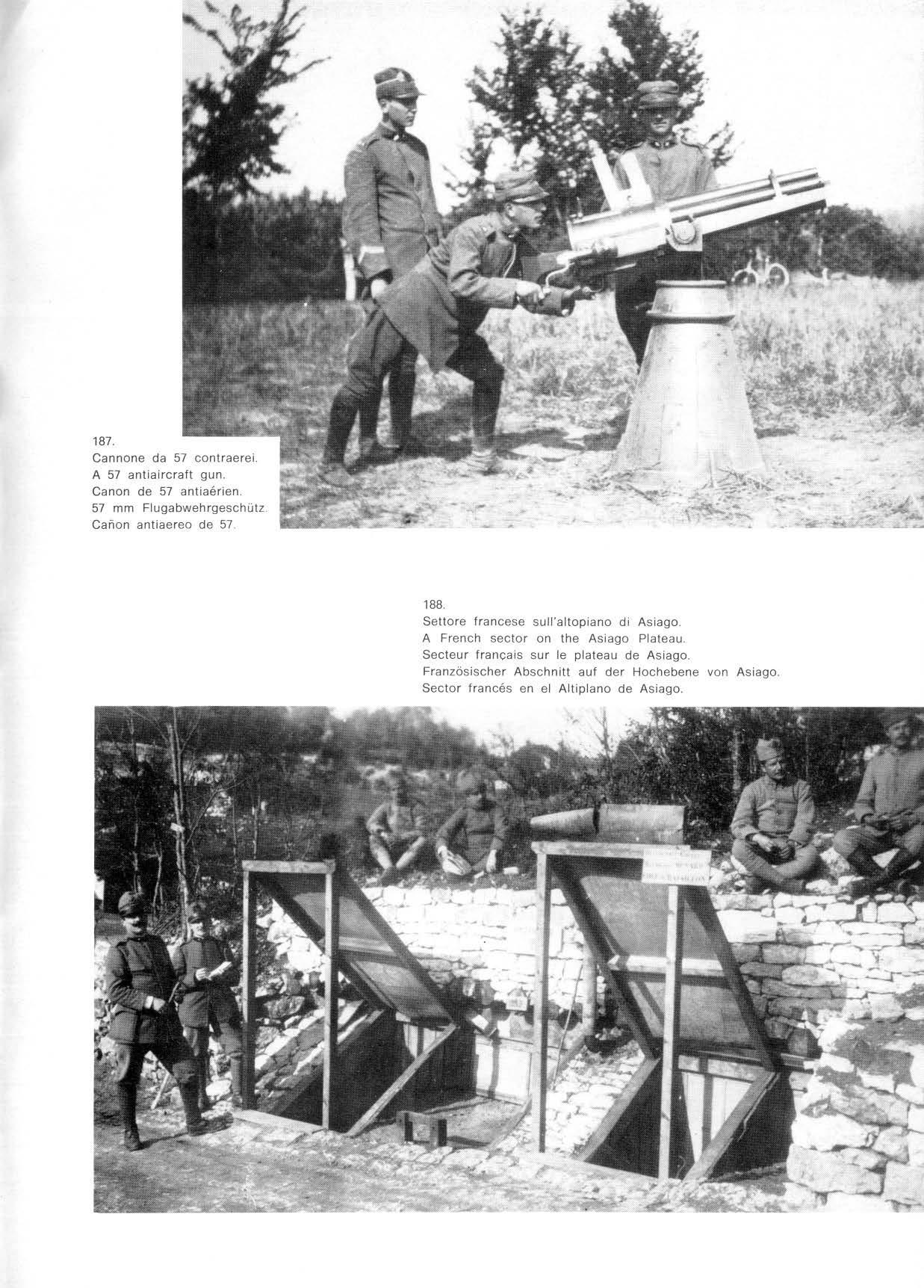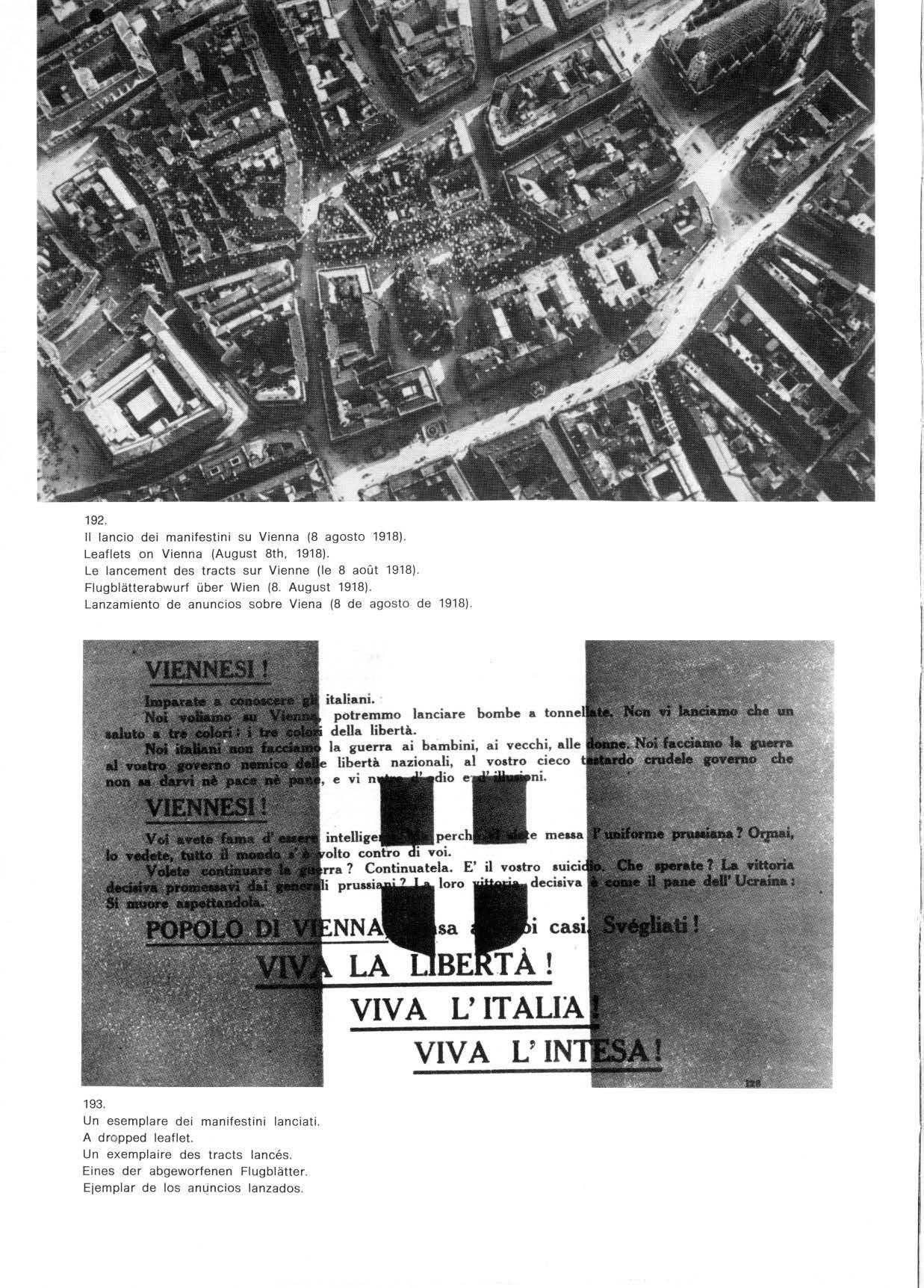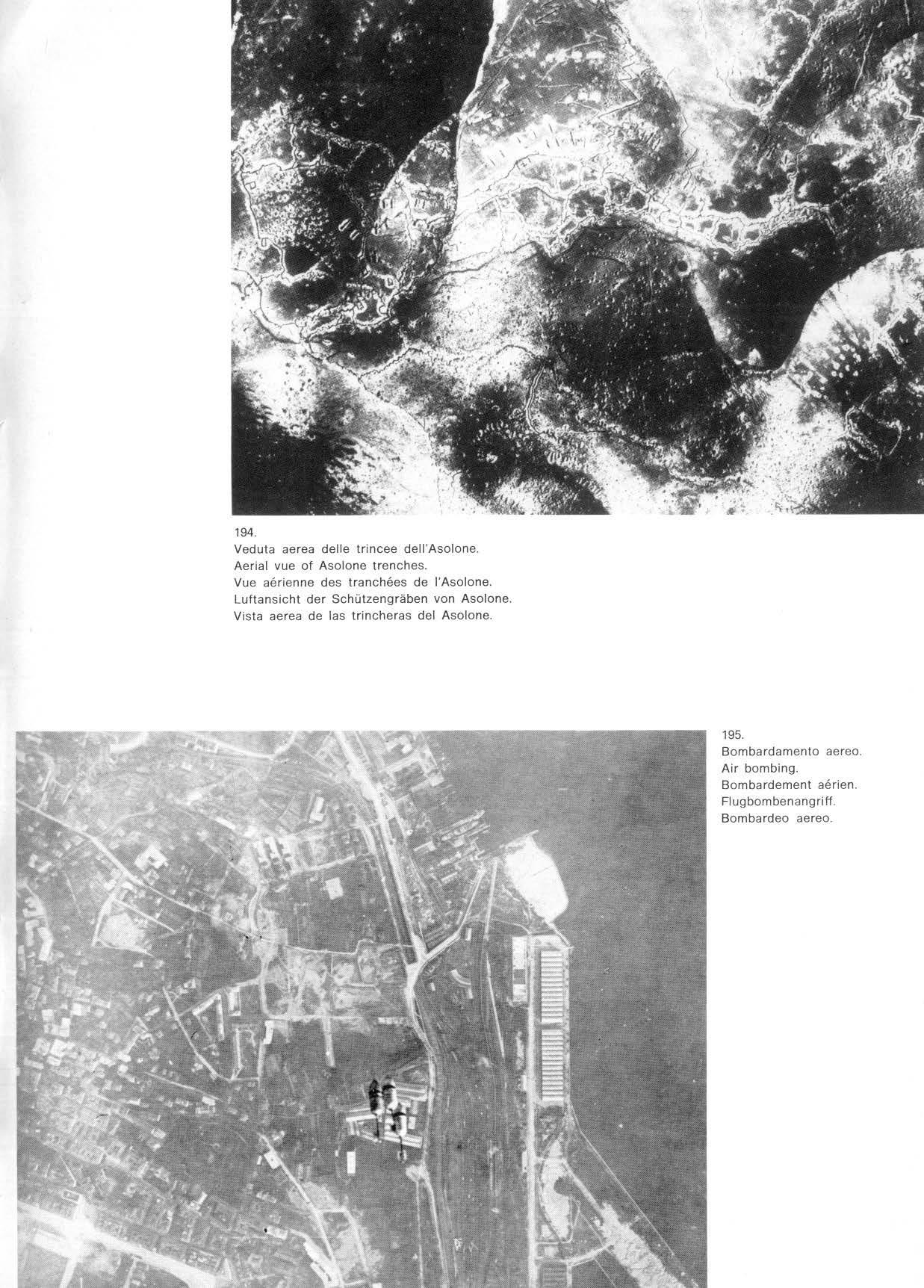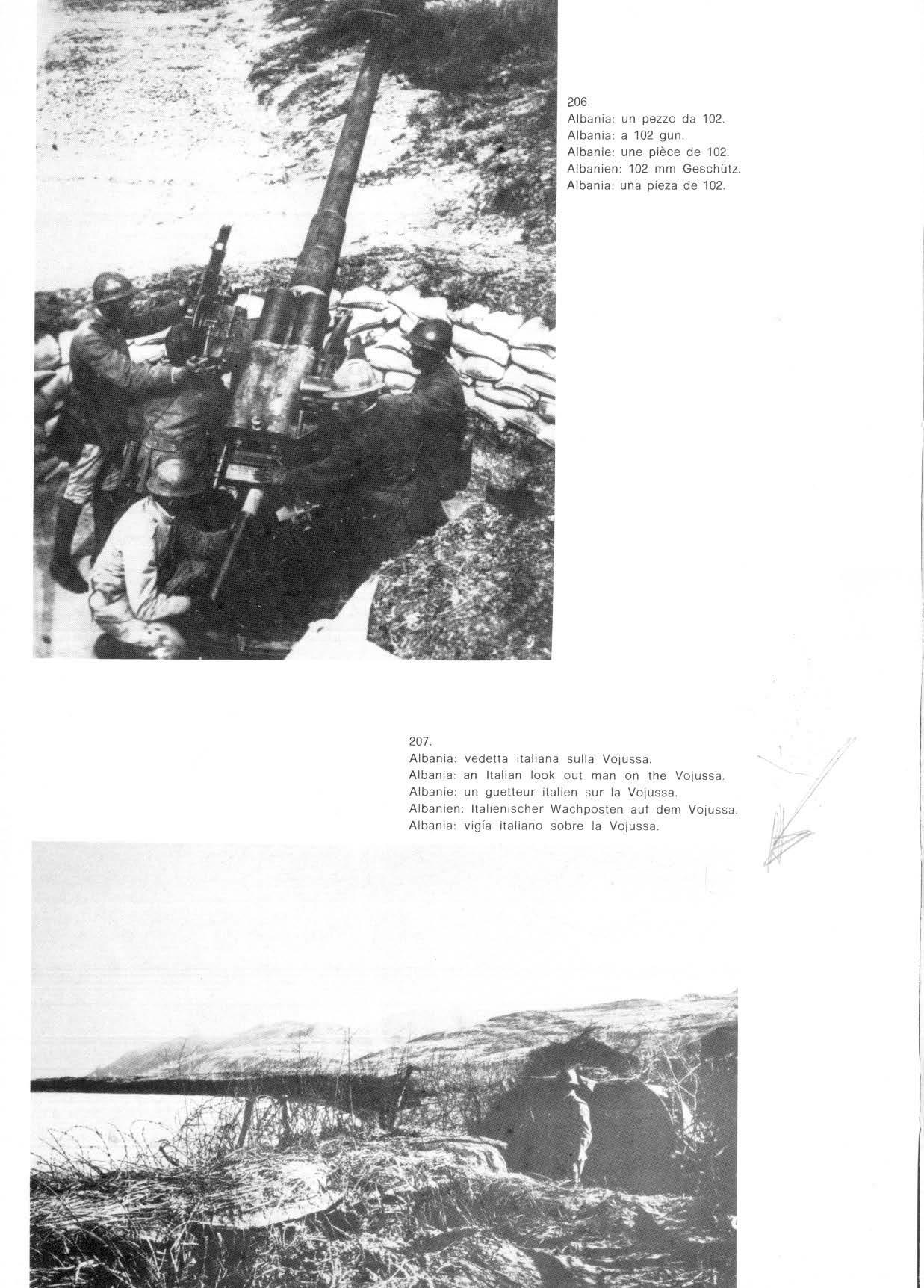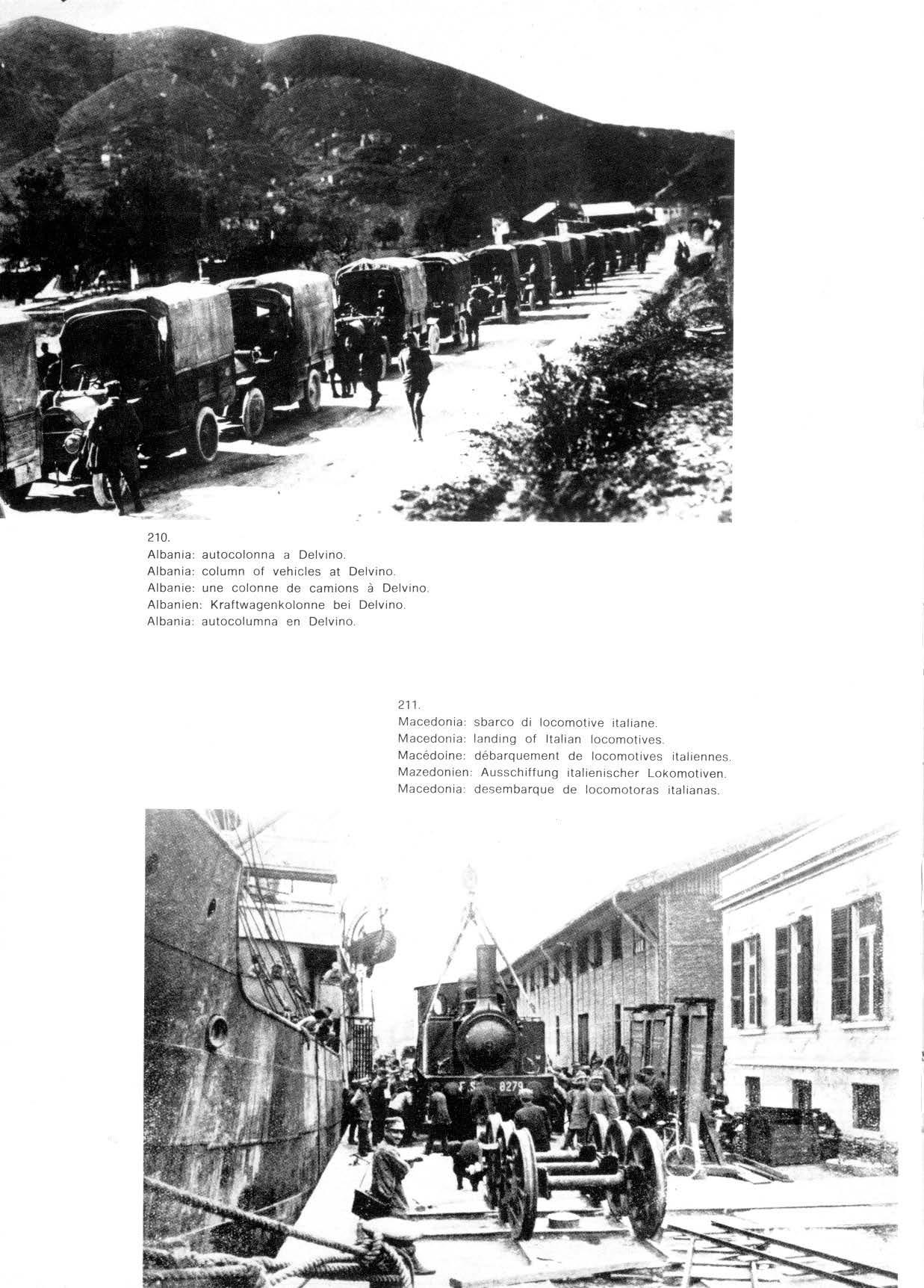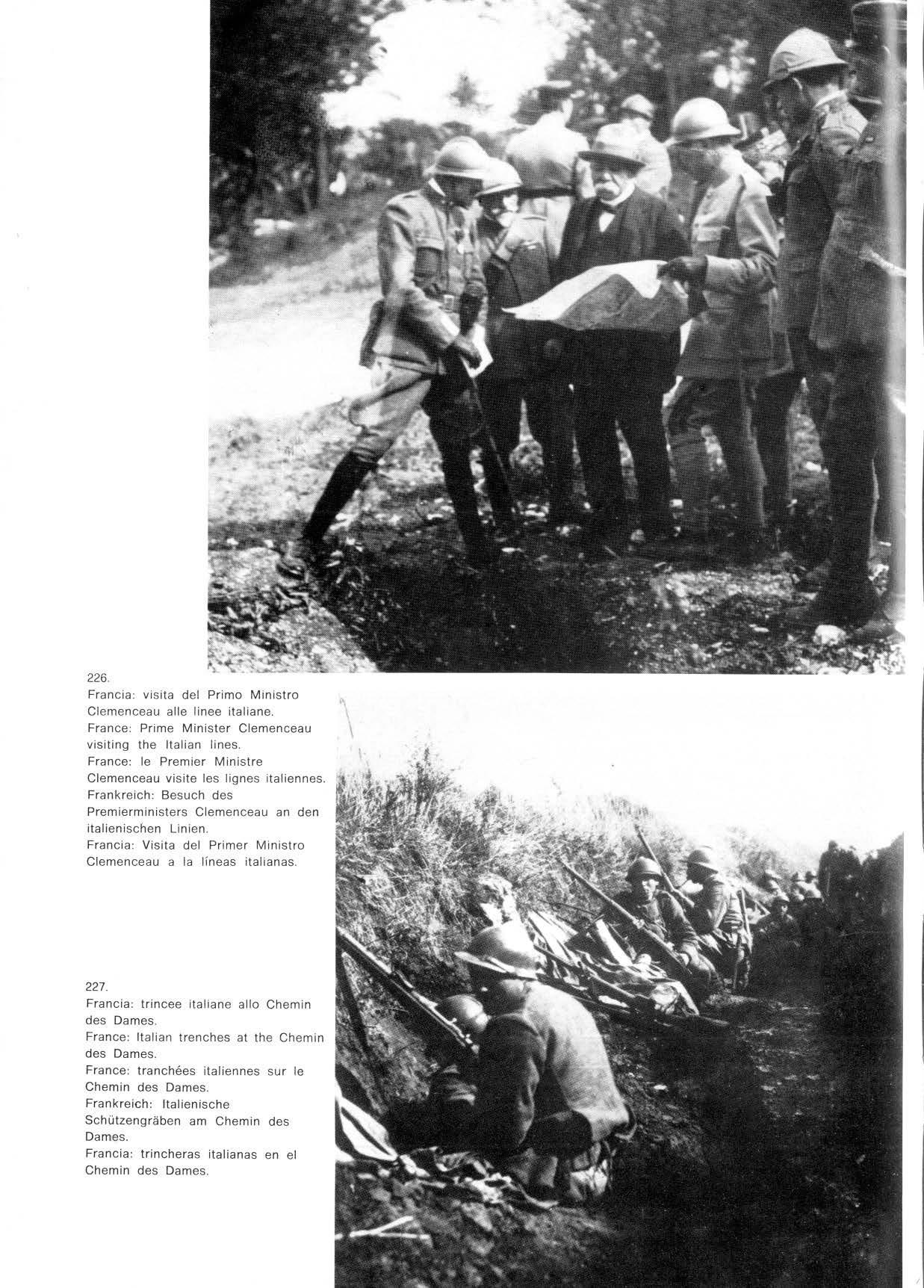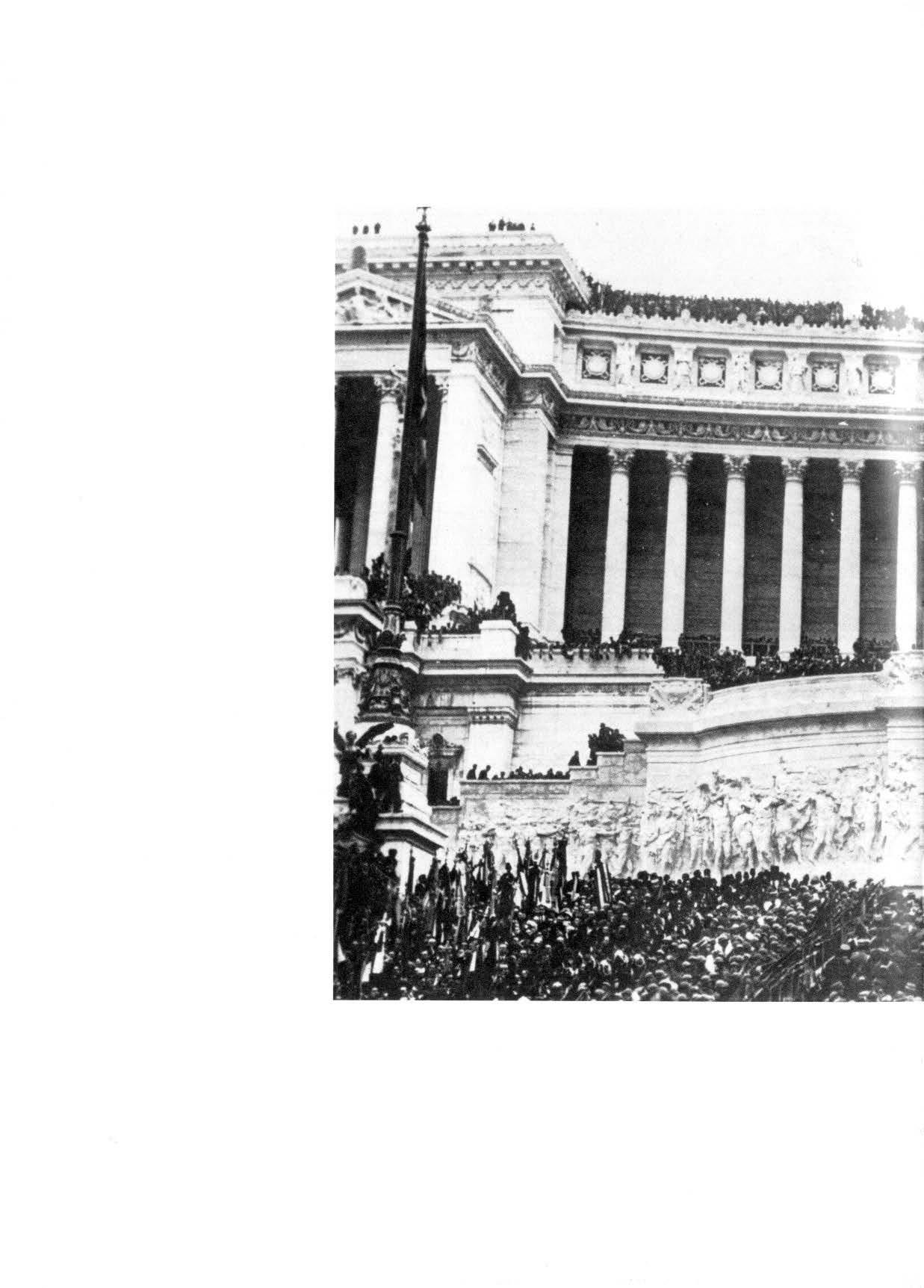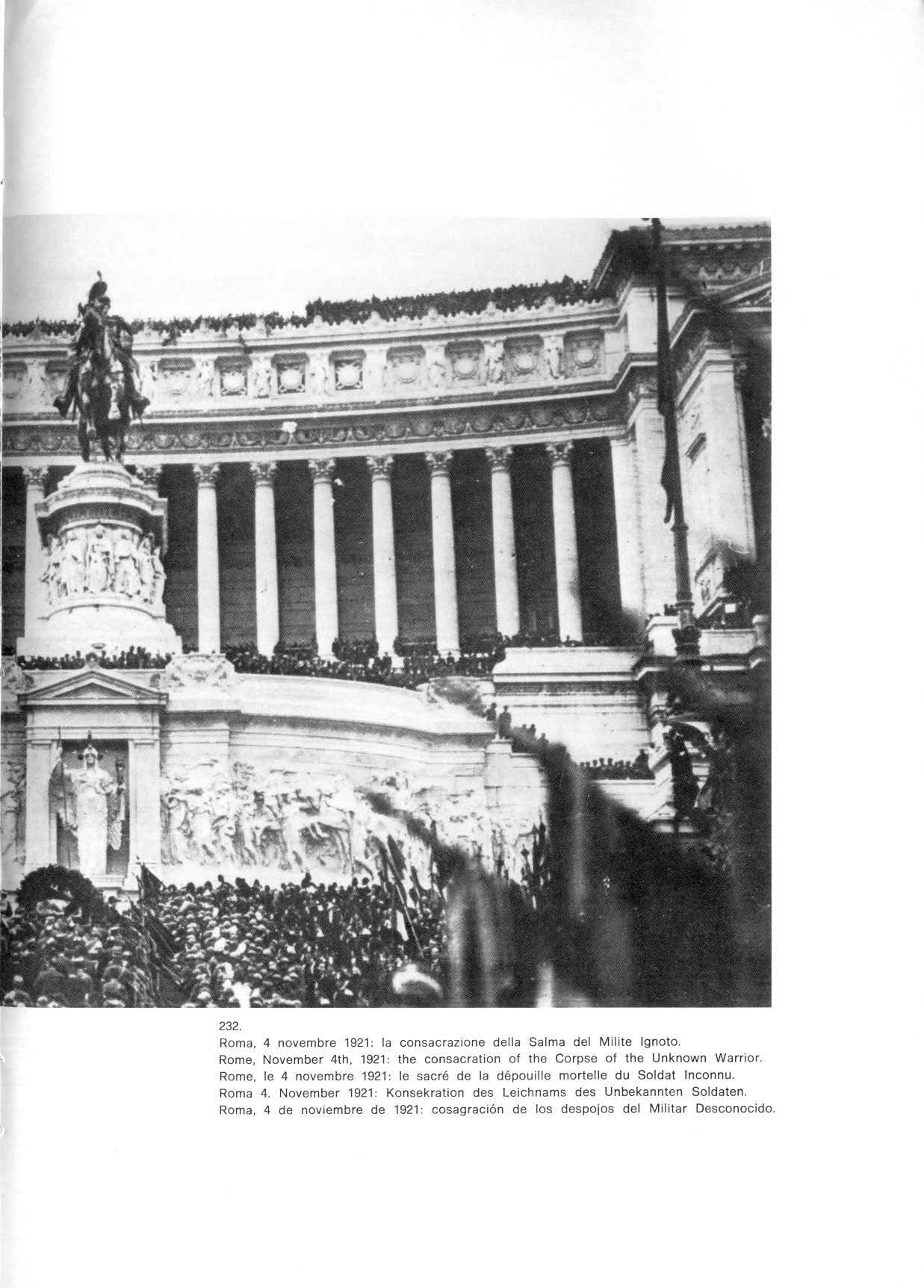




1a G U ERRA M O N D I AL E


<" ~resente volume è stato redatto dal
Colonnello f . t.SG Oreste Bovio .
Ricerche documentali a cura de l Capitano f. Nicola
Della Volpe
Traduzioni a cura di : Colonnello c t.SG Luigi Trinchieri , Ten Col. a. s SM Giuseppe Marraffa, Ten Col. f (alp.) s .SM Ezio Sessich , Ten . Col. f (cr.) t.SG
Antonio Tomasicchio



Sono trascorsi sessanta anni dalla conclusione della prima guerra mondiale, la guerra che coronò il ciclo del nostro Risorgimento completando, con il raggiungimento dei confini naturali, l'unità politica della Nazione.
Nella consapevolezza della validità degli ideali risorgimentali e nel ricordo del sacrificio allora compiuto da 680.000 Caduti e da oltre un milione di mutilati e feriti, questa pubblicazione è dedicata a tutti i combattenti di quell'immane conflitto.
Sixty years have passed since the conc/usion of the first world war, the crowning war of our Risorgimento, which completed, reaching the country's natural borders, the politica/ unity of lta/y.
Recognizing once again the soundness of Risorgimento' s ideals , this book is dedicated to ali the soldiers who tought that tremendous war , as a memory tor the sacrifice made by 680.000 fallen and by more than one milion of cripp/ed and wounded
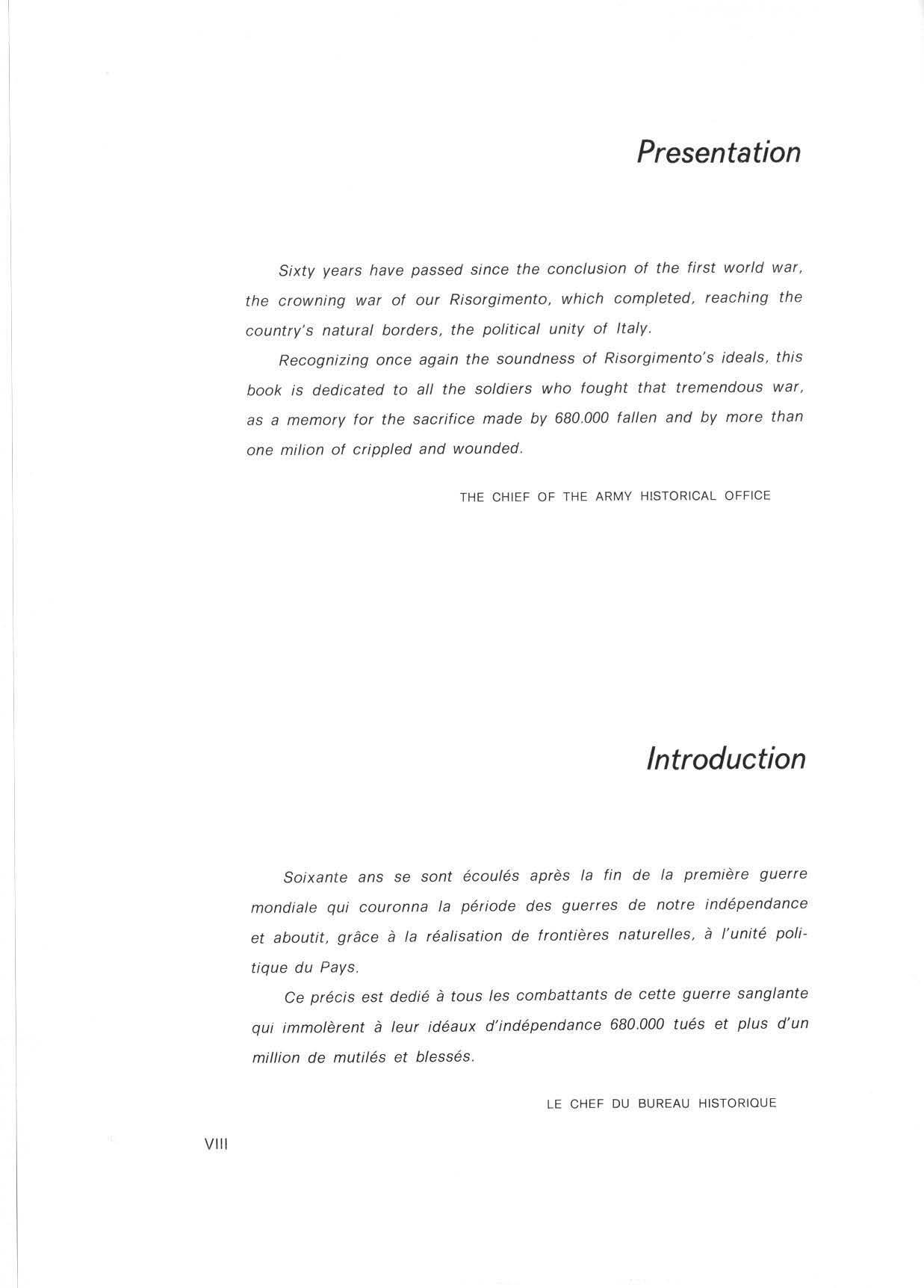
Soixante ans se sont écoulés après la fin de la première guerre mondiale qui couronna la période des guerres de notre indépendance et aboutit, grace à la réa/ìsation de frontières naturelfes, à l'unité politique du Pays.
Ce précis est dedié à tous /es combattants de cette guerre sanglante qui immolèrent à leur idéaux d'indépendance 680.000 tués et plus d'un million de mutilés et blessés
Sechzig Jahre sind seit dem Ende des ersten Weltkrieges vergangen, dem Krieg, der den Zyklus unseres Risorgimentos kronte und der mit der Fest/egung der naWrlichen Grenzen die pofitische Einheit der Nation vervol/standigte .
lm Bewusstsein , dass diese Ideale des Risorgimentos ihren Wert hatten und im Andenken an das Opfer, das dama!s 680.000 Gefallene und mehr a/s eine Million Kriegsversehrte und Verwundete brachten, ist diese Ausgabe allen Kampfern ienes gewaltigen Konfliktes gewidmet
DER AMTSCHEF DES GESCHICHTLICHEN AMTES
Desde hace ya sesenta anos termino la primera guerra mundial, la guerra que corono e/ ciclo del nuestro Resurgimiento al completar la unidad politica nacional con e! a/canee de Jos confines natura/es.
En la conciencia de la va/idez de los idea/es resurgimentales y en e/ recuerdo del sacrificio hecho entonces por 680.000 CaTdos y mas de un mii/on de mutilados y heridos, la presente publicaci6n es dedicada a todos los combatientes de aquel inmenso conflicto.
EL JEFE DE LA OFIC INA H1ST6RICA



In previsione del l'entrata in guerra il Capo di Stato Maggiore italiano , Generale Cadorna , aveva stabilito : difensiva sul fronte trentino ; offensiva a fondo su l fronte giu lio in direzione di Lubiana e Zagabr ia; eventuali offensive concorrenti dal Cado re e dal l a Carnia
Il piano. i n apparenza ambizioso. si giustificava con un presupposto fondamentale : il concorso dell'esercito serbo da lla bassa Sava verso Lub i ana e del l'esercito russo dai Carpazi nella p i anura ungherese Di conseguenza l'esercito che, a radunata effettuata (13 giugno 1915), contava 569 battaglioni. 173 squadroni. 512 batterie, fu schierato per due qu inti a sbarramento dei 560 km di frontiera intercorrenti tra lo Ste lvio e M Canin, per due quinti sul fronte giul io (70 km) mentre un quinto fu tenuto in riserva.
L'esercito austro - ungarico alla fronte italiana , deciso a tenere, almeno per il momento , un attegg i amen t o difensivo era forte di 234 battaglioni, 21 squadroni, 155 batterie, a c u i va agg iunto I' Alpenkorps bavarese, dis locato nel Trent ino anche se ufficialmente non esisteva ancora stato di guerra tra Ita lia e Germania
Le forze austro - ungariche, numericamente inferiori, avevano il grande vantagg i o di combattere da posizio n i naturalmente forti e compiutamente o rganizzate a difesa. con ope re di fortificazione perma nente e lavori campa li.
Il primo anno di guerra .
Quando l'Ita l ia en t rò in guerra (24 maggio 1915) i l piano era già inattuabile . I Russi, d u ramente battuti i n Gal i zi a, erano costretti ad una perico losa e profonda r i t ira t a - tan t o che gli Aust ri aci fur ono in grado di ritirare da quel fronte alcune divisioni subito sc h ierate in Italia - ed i Se r bi erano caduti in u na fase di stra na inerzia.
Venuto così a mancare l'i ndispe nsab ile appoggio indiretto degli Allea t i, l e ope razioni iniz i ali ital i ane ebbero lo scopo più modesto di occupare buone posizioni di partenza. idonee ad agevolare g li ulte r iori svil u ppi ope rat i vi.
I comba tt ime nt i in i zi ali no n ri uscirono, pe rò, a proc u ra r e g li agognati sbocchi offensivi oltre l' Isonzo ed il Genera l e Cadorna ripiegò allora su obiettiv i p iù limita t i. propone ndos i per i l momento la co nqu ista di Gori zia e di Tolmino.
Era ch i aro, infatti, che anche i n Ital i a, come già da mesi in Francia e nelle F i andre, l a co nt inui t à del fronte. saturo di t r uppe, e l'equ ilibrio tra le forze contrapposte imponeva no l a g uer r a d i posizione . X l
Il 23 giugno ebbe inizio la 1" battaglia dell'Isonzo.
La lotta si protrasse vio lenta ed accanita per quindici giorni consecutivi, ma il tentativo di conquistare To lmino fallì e sul Podgora il nemico resisté efficacemente. Più a sud, si stabilirono le prime teste di ponte oltre l ' Isonzo
Fu l a prima duriss ima, sanguinosa prova per l'esercito italiano : 15.000 perdite
Dopo soli undici giorni d i tregua, il 18 luglio, la battaglia si riaccese su tutto l'Isonzo. Concettualmente, questa seconda battaglia era la prosecuzione della precedente.

I risultati furono modesti, ma enormi le perdite : 42.000 uomini. Pari que lle austro - ungariche.
Dal 18 ottobre al 4 novembre e dal 10 novembre al 2 dicembre si svolsero ancora su l fronte giulio la 3" e la 4" battaglia dell'Isonzo, tendenti alla conquista del medio Isonzo.
Queste operazioni, analoghe alle azioni intraprese su l fronte francese, furono decise da Cadorna per alleggerire l a pressione esercitata sug li eserciti russo e serbo dagli Austro - Tedesch i
In un mese e mezzo di lotte sanguinose (116.000 furono le perdite i t aliane e 70 000 quelle austriac h e) la 2• e 3' Armata riuscirono ad intaccare il sistema difens ivo avversario, ma non ad infrang erlo.
Le grandi operazioni del 1916 furono sei: la 5" battag l ia dell' Isonzo, combattuta per venire in aiuto dei Francesi impegnati a Verdun; l'offens iva austriaca ne l Trentino e l a co n seguente controffensiva italiana ; le battaglie dell'Isonzo 6" , 7", aa e 9'1.
Di esse rivesto n o grande importanza: la battaglia del Trentino e la 6" battaglia dell'Isonzo, che portò alla conquista di Gorizia.
La dec isione di attaccare l'Italia attraverso g li Altipiani, per scendere nella p i anura vicentina e cogliere alle spalle le armate sch i erate sul fronte della Venezia Giulia, real izzava un antico progetto del Capo di Stato Maggiore austriaco, Maresciallo Conrad Per poterlo eseguire con maggiori probabilità di successo furono r i chiamate da l fronte orienta le le migliori unità austriache, circostanza della qua le approfittò subito la Ru ssia per attaccare gli Austro - Tedeschi ed inf l iggere loro una pesante sconfitta (Lutsk, giugno - lug lio 1916)
Il 15 maggio duecento battaglioni austro - ungarici si avventarono sulle posizioni ita liane poste tra l'Adige e i l Brenta Sotto la rabbiosa i rruenz a del l'a ttacco , la l inea difensiva ebbe una flessione, ma si ancorò su posizio n i più arretrate ed i l 3 giugno Cadorna poteva già annunc i are che l'offe n siva austriaca era stata arrestata su tutto il fronte. Le truppe ita liane passa rono quind i alla controffens iva e gli Austriaci furono d i nuovo ricacciati ben dentro la zona montuosa tridentina.
Subito dopo la vittoria difens iva nel Trentino iniziò la 6" battag lia dell'Isonzo (4 - 17 agosto): la battaglia d i Gorizia, che costò perdite assai gravi. compensate però dalla conquista di posizioni ritenute inespugnabili: il Calvario, il M. San Michele, il Sabotino e Gorizia.
Seguirono, nel breve giro di due mesi, dal 14 settembre al 4 noXli vembre , t re consecutive ba tt aglie che ebbero lo scopo d i l ogo r are sempre
di più l'avversario e che tendevano alla conquista d i posizioni idonee ad aggirare da sud le alture orientali di Gorizia e da nord l'Hermada
Terminava così il 1916 senza che si fosse giunti a risultati decisivi, rimandati al 1917, anno nel quale, secondo quanto convenuto nella 2• Conferenza di Chantilly del novembre 1916, si sarebbero dovute sviluppare violente offensive contemporanee su tutti i fronti dell'Intesa

Ne l maggio 1917, infatti, mentre era ancora in corso in Francia la grande offensiva di primavera, il Comando Supremo italiano decise di attaccare lungo tutto il fronte isontino .
L'azione si svi luppò dal 12 al 28 maggio (10" battaglia dell'Isonzo) e portò alla conquista ita liana del Kuk e del Vodice.
Successivamente, dal 10 al 29 giugno. l'esercito italiano condusse una operazione di attacco nel settore degli Altipiani, la battaglia dell'Ortigara, conclusa senza alcun risultato positivo e con il passivo di gravissime perdite (26.000 uomini) , specie nelle truppe alp ine
Subito dopo fu decisa una nuova azione offensiva (11 " battaglia dell'Isonzo) che avrebbe dovuto conseguire l'occupazione dell'Alt ipia no della Bainsizza e dell'Altipiano di Comen.
L'offensiva. simu l tanea nei due settori, durò complessivamente dal 17 al 31 agosto e conseguì qualche risultato
La 2" Armata riuscì a penetrare nell'Altipiano della Bains i zza per una profondità di circa 8 km senza, tuttavia, raggiungere il risultato di scacciarvi del tutto gli Austriaci. La 3" Armata ottenne , invece , solo modesti successi, spostando di poco il fronte in avanti ne i pressi dell'Hermada Fu questa, l'ultima battag lia offensiva italiana sul fronte isontino.
L'eserc i to ita liano si andava così sempre più logorando e nei reparti combattenti si affievol iva l a speranza di po t er alla fine aver ragione della barriera di roccia e di ferro che stava loro di fronte. La sfiducia, alimentata anche dalle correnti neutralistiche mai sopite nell'interno del Paese. provocò naturalmente un indebolimento della compagine morale con incidenze sul tono disciplinare.
Anche l'avversario cominciava però ad accusare seriamente il peso dei colpi che si erano abbattuti su di lui, tanto da indurlo a chiedere l'aiuto dell'alleata Germania.
La inattività sullo scacchiere francese, dopo il fallimento dell'offensiva N ivelle. ed il crollo pressoché totale dell'esercito russo. permisero che sette div isioni tedesche aff luissero in Italia, costituendo con 8 divisioni austriache la 14" Armata
All'alba del 24 ottob re la 12' divis i one germanica, sboccata da To lmino. sfondò la linea italiana e, percorrendo l a valle dall'Isonzo. a tergo della difesa avanzata. raggiungeva Caporetto alle ore 15. Al seguito di questa divisione. il corpo alpino tedesco nella giornata conquistò tutta la regione or ientale del Ko l ovrat. caposaldo della d i fesa di seconda linea italiana
Il mov imento delle prime due unità germaniche fu immediatamente seguito da altre 5 divisioni .
Alla sera del 24 ottobre era stata g i à aggirata la destra della 1a e 2" linea di difesa, da Tolmino a Kolovrat, e superato il centro della 3" linea a Caporetto.
L'indomani gli Austro - Tedeschi diedero ampio respiro alla loro manovra o l trepassando l'Isonzo a Saga e spingendosi verso Monte Maggiore. A nord. la 10" Armata austriaca mosse verso il Tagliamento; al centro, l e truppe al seguito della 12• divisione tedesca da Caporetto rag- Xlii
giunsero la cresta l atera l e del Matajùr; l'ala sinistra del d i spositivo di attacco puntò dal Kolovrat su lle strade di Cormons e di Cividale.
Supe rate, nella giornata del 26, quasi tutte le posizioni difensive montane, la 14" A r mata, sboccata in p i anura, puntò su Civida l e, mentre la 10", a nord, raggiunse la va lle del Fella. Il Gruppo Armate Boroevic iniziò anch'esso l'offensiva sul Carso.
Al l e ore 2 del 27 ottobre il Comando Supremo ita liano ordinò i l ripiegamento generale.
Era stata scelta, quale prima linea di resistenza, que lla de l Tagliamento; ma poi si constatò la necessità di ritirarsi sino al Piave
Nel l a giornata de l 9, tutte le truppe superstiti avevano raggiunto la sponda destra del Piave, dove una parte dell'esercito si era schierata per far fronte all'invasore.
Il Comando austr iaco decise d i proseguire ulteriormente l'offensiva , sino alla totale distruzione dell'esercito ita liano.

La battagl i a d'arresto si sv iluppò in due fasi: dal 10 al 26 novembre e dal 4 d i cembre al 30 dicembre.
Nel l a pr ima gli Austro - Ungar i c i attaccarono lungo i l Piave, riuscirono a penetrare n ell'ansa d i Zenson ed a far arretrare la linea di f ensiva a sud di Musile, lungo la Piave Vecch i a ed il Sile. Nonostante questi successi locali l'offensiva fallì e il 26 n ovembre i l Comando Supremo austroungar i co ordinò la sospens i one del l'attacco.
Frattanto erano state riordina t e al tre division i i tal i ane e, tra il 4 ed i l 5 dicembre, divisioni francesi e ing l esi ent r arono in l inea fra i l M. Tomba e il Monte l lo .
Il 4 dicembre 1'11 " Armata aus t ro - ungarica dette inizio a lla seconda fase attaccando le Melette e riuscì a impadroni r sene, ma fu arrestata sul l a linea Col d'Echele, Col del Rosso. Monte Valbe lla .
L'11 dicemb re la 14" Armata aust ro - tedesca riprese l'offensiva sul Grappa : con dur issima lotta riuscì a porre piede sul Col della Berretta , Col Capri l e, Monte Aso l one. Monte Spinoncia, ma si esaurì con questi limi t at i successi. Un ultimo suss u lto offensivo si ebbe sul l'Altipiano. dove si svolse la « battag lia di Nata le». Il 25 dicembre i l l ii Co r po austroungar i co a t taccò e riuscì a impadronirsi di M. Valbe lla e di Co l d'Echele, ma la difesa si conso lidò sulla retrostante l in ea Cima Ec h ar - Monte Melago - Pizzo Razea.
La dura battaglia si concluse con i primi in successi deg l i AustroUnga r ici: il 30 d i cembre la 47" divisione f rancese r i conquistò la dorsa l e fra M. Tomba e i l M onfe nera ed il 31 l e tru ppe italiane eliminarono la penetraz ione ne ll'ansa di Zenson.
La battaglia d i Caporetto costit uì indubbiamente per l'esercito i taliano un dolo roso in successo, ma due c ircos t anze debbono essere prec i sate:
- so l o l'a n dame nto geog rafico del l a linea di confine tramutò un i n successo di ord in e tatt i co in u na sconfitta di carattere st r ategico;
- Ca p oretto rapp r esen t ò per gli I t al i ani so lo un episod i o sfor t una t o, al q ua l e - da so li e rap idamente - seppero po rr e r imedio.
La riti rata al Piave, infatt i, vo luta e condo t ta con freddezza e lucidità dal Gene ra le Cado rn a (fu sostituito dal Ge n era l e Di az il 9 novembre), fu u n fatto esclus i vamen te i tal iano, così come la success iva v ittoriosa batX IV tagl i a d'a rr esto.
Conclusa tale battag lia, mentre tutta l'Ital ia sosteneva il Comando Supremo nell'op era di totale riorganizzazione dello strumento militare, l'esercito italiano non rimase inattivo. Sull'Altipiano dei Sette Comun i fu organizzata , dal 28 al 30 gennaio. un'azione offensiva, vittori osamente conclusa con la riconquista della linea M. Valbella - Col del Rosso - Pizzo Razea. Analoga rettifica della linea di con tatto fu compiuta nel maggio, nel gruppo del l'Adamello.

Nel marzo, sferratasi in Francia la grande offensiva tedesca, 4 divis i on i francesi su 6 e 2 britanniche su 5 poterono venir ritirate dal fronte italiano senza provocare alcun problema.
Le ultime battagli e.
Gli Imperi Centrali con l'offens iva dell'autunno 1917 non erano riusciti a mettere fuori causa l'Italia Il tempo giocava a favore de ll' intesa e si impon eva, quindi, per essi una rapida risoluzione de lla guerra, da ricercarsi con grandi offensive strategiche.
Questa la ragione determinante de ll'offensiva austriaca deJ giugno
1918 .
Il piano operativo prevedeva: sforzo principale a cava llo dei Brenta , tendente a sfondare rapidamente il fronte montano, raggiungere la pianura ed avvolgere le unità impegnate nella difesa del Piave; contemporaneo attacco de l Gruppo Armate dell'Isonzo in direzione Treviso Mestre, con primo obiett ivo la linea del Bacchiglione Un attacco al Tona le, accompagnato da diversioni nel l e Giudicarie e in Val Lagarina, doveva precedere le a l tre operazioni allo scopo di fissare le forze italian e.
Comp less ivamente le forze austro - ungariche contavano 60 divis ion i, d i cui 50, dall'Astico al mare , dest inate al l'atta cco e 7 500 bocche da fuoco di tutti i calibri. alle quali l'esercito italiano contrapponeva 56 divis i oni di fanteria (50 italiane, 3 britanniche, 2 francesi. 1 cecoslovacca), deile qua li 19 in riserva, 3 divisioni di cavalleria e 7.053 pezzi di artiglieria
A ll'alba de l 12 giugno si scatenò un violento fuoco di artiglieria . Era l' inizio di quell'azione dimostrativa ad ovest dell'Astice con la quale il nemico si riprometteva di fissare le forze italiane.
L'efficace fuoco di contropreparazione e l'intensa reazione del l e mitragliatrici stroncarono immediatamente ogni ve lleità austriaca. L'attacco diversivo si risolvette così i n un deciso insuccesso.
A lle ore 3 de l 15 giugno l'artiglieria austro - ungarica inizi ò il bombardamento de l fronte da ll'Astico al mare. ma già si era scatenato, con estrema violenza, il fuoco d i contropreparazione ital i ano
Ne l settore montano gli attacchi si esaurirono subito mentre ne lla zona de l Piave gli Austriac i riusc irono a passare su lla destra del fiume, malgrado la forte reazione italiana.
La breccia aperta permise al l 'attaccante di impad ronirsi del saliente del Montello e di costitu ire su lla destra de l fiume due teste di ponte, a Fagarè ed a Musi l e.
Nonostante i d ispe rati sforz i austro - ungarici nei due giorni successivi la situazione non mutò, né sugli Altipiani né tra Brenta e Piave; sul basso Piave un poderoso attacco austriaco riuscì bensì a congiungere l e due teste di ponte, in corrispondenza di Ponte di Piave e S Donà, ma non poté progredire ulteriormente XV
La caparbietà con la quale le divisioni austro - ungariche reiteravano i loro attacchi serviva in pratica soltanto a falcidiare sempre più le loro forze La sera del 17, infatti, la pressione dell'attaccante era ormai contenuta dappertutto. Nei giorni successivi si manifestò la definitiva sconfitta delle truppe austriache , che nella notte sul 23 iniziarono la ritirata o l tre il Piave
La battaglia del Piave. costata agli Austriaci 150.000 uomini, fu una grande vittoria italiana , la prima conseguita nel 1918 da un esercito dell'Intesa
Durante l'estate il Gen. Foch rinnovò più volte al Gen. Diaz la richiesta di effettuare un'offensiva Diaz temporeggiò perché era opportuno attendere il momento propizio per impegnare una battaglia che fosse decisiva
Dalla metà di luglio il Comando Supremo tedesco aveva perduto l' iniziativa sul teatro di guerra francese e le offensive alleate costringevano l'esercito germanico ad effettuare successive ritirate, senza però perdere la sua compattezza.

Fra il 16 e il 19 settembre I'« Armée d'Orient » fece crollare il fronte tedesco - bu lgaro nei Balcani e i l 29 settembre fu concluso l ' armistizio fra gli Alleati e la Bulgaria
Il Comando Supremo italiano vide allora la possibilità di rompere il fronte avversario in corrispondenza della zona di sutura delle due armate austriache (5" e 6" ) del Pi ave. agendo a cavaliere della direttrice di Vittorio Veneto.
La manovra avrebbe dovuto avere inizio i l giorno 16, ma la piena del Piave ne fece spostare l a data al 24 ottobre.
La battaglia fu iniziata dalla 4 a Armata, che protrasse i suoi attacchi sino al giorno 27 , riuscendo nell'intento di richiamare ed assorbire le r i serve austriache
Nella notte tra i l 26 ed i l 27 le armate italiane 8 \ 12• e 10• gettarono i ponti sul Piave e passarono il fiume.
L'irruenza dell'attacco costrinse il Comando della fr' Armata austroungarica ad ordinare, il giorno 28, la ritirata sul Monticano
Il giorno 30, 1'8• Armata occupò, con le proprie avanguardie , Vittorio Veneto; la 12" Armata superò la stretta di Ouero verso Feltre; la 10" varcò i l Monticano in direzione di Saci l e.
Nella serata dello stesso giorno si presentava al nostro Comando Supremo il Generale austriaco Weber per trattare la resa . Le trattative però non furono spedite perché il Governo austro - ungarico non voleva firmare una capitolazione completa. ma solo una tregua d'armi. Durante la discussione le operazioni continuarono ed il 31 le truppe austriache del Grappa cedettero , infine, all'irruenza dell'azione della 4" Armata che mosse allora su Arsiè; la 12a Armata si diresse su Feltre; 1 ' 8• sboccò nella valle del Piave a Ponte delle Alpi; la 10" affiancata dalla 3", raggiunse la Livenza e la cavalleria i l Tagliamento ; si mise in moto anche la 6· Armata lungo la Val Sugana. per intercettarvi la rotabile e dirigersi verso Trento - Egna
Il 3 novembre la 1" Armata entrò a Trento, tutte le altre armate ragg iunsero i rispettivi obiettivi e, mentre l a cavalleria si spingeva fino a Palmanova , Udine e Stazione per la Carnia, un apposito distaccamento sbarcò a Trieste.
La sera del 3 novembre fu fina lmente concluso l'armistizio di Villa Giusti : alle ore 15 del 4 novembre 1918 vennero sospese le ost il ità su XVI tutto i l fronte italiano
Spinto dal l'odio secolare, dalla salda disciplina, dal sentimento de ll'onor mi litare , l'esercito imperia l e si era battuto assa i coraggiosamente anche nell'ultima battaglia, tanto che le perdite furono sensibili: 36.498 italiani e 2.498 alleat i .
Con la battaglia di Vittor i o Veneto l'Ita lia non sconf i sse soltanto « uno dei più potenti eserciti de l mondo». ma provocò il crollo totale dell ' Impe ro deg li Absburgo.
Lo sforzo fu immenso - 5 m ilioni di uomini mobilitati , 900.000 mi lita r izzati nelle indust r ie di guerra, 680 000 caduti, oltre 1 milione di feriti e muti lati - ma il ciclo storico del Risorgimento italiano si concludeva inf in e con il raggiungimento dei confini naturali.
Gli altri fronti.
Per completare i l quadro deg li avven imenti è necessario almeno accennare al contributo ital iano alla vittor i a comune fuori del territorio nazionale

In A lbania, dopo lo scoppio della guerra. l'Ita lia occupò l' isolotto di Saseno e poi (29 dicembre 1914) Va l ona a sa lvag uardia deg l i interessi italiani nell'Adriatico
Gli Austro - Tedeschi iniziarono l'8 ottobre del 1915 l'offensiva a fondo contro i Serb i, con l'a iuto dei Bulgari. Lo sbarco di un primo contingen t e franco - inglese a Sa l onicco non servì a mantenere aperta ai Serbi la via di ritirata ed essi furono costretti a cercare scampo verso i porti albanesi.
L'Italia si ass un se allora il comp ito di proteggere la ritirata e l'imbarco dei resti dell'ese rcito serbo. Fu costituito un Corpo d'occupaz i one dell'Albania, su una divisione di tre b r igate, una delle quali doveva portarsi a Durazzo , mentre le alt re due avrebbero garantito il possesso di Valona. La brigata « Savona » raggiunse così Durazzo, dove si sistemò a difesa per proteggere l'imbarco de i Serbi, ultimato il 9 febbraio 1916: dal 23 a l 26 febbraio l a br igata, che aveva trattenuto g li Aus t riac i per altre due sett imane, si imbarcava sotto la protezione d i unità de ll a flotta
Rimaneva in possesso degli Ita lian i la baia di Valona Le forze in A lba n ia vennero gradua lmente aumentate, raggiungendo la consistenza di un Corpo d'A r mata (XV I) di c i rca 100.000 uomini. su tre divis i on i Essendosi inta n to il Corpo d i spedizione in ter alleato d i Salonicco (A rmata d'Oriente) spinto verso occ idente. le t r up pe ita liane d'Alban i a prendevano co nt atto con esso ad Erseke. costit u endo così un fronte continuo dall'Adr i atico all'Egeo.
Nel magg i o 1918 una az ione comb in ata it aliana e francese sulla destra dell'Ossum e verso la Tomoritza riu scì a rendere pi ù s i c ura la strada Erseke - Sa l onicco e. nel lug l io, un attacco ita liano, appoggiato su lla destra dai Francesi, fu e f fet t ua t o contro l e due ali della Malakastra.
Alla f in e di settembre, in co nnes sio n e con l'offensiva dell'Armata d'Oriente, il XVI Corpo d'A r mata riprendeva l' avanzata, occupando Durazzo i l 14 ottobre. Tirana il 15, Scutari il 31 ed infin e Dulc igno ed Antivar i il 3 novembre.
Costituitas i sul f in ire del 1915 l' Armata d'Oriente (A rmée d'Orient). Governi allea ti r ichiesero a quello ita liano truppe per l a Ma cedo n ia. XVII
Il 9 agosto 1916 iniziò quindi il suo imbarco a Taranto l a 35" divisione . che si schierò i l 25 agosto sul l a l inea Krusa - Balkan fronte di 48 chilometri.
La divisione partecipò nel settembre dello stesso anno ad un'azione controffensiva; venne quindi trasferita nel settore di Monastir (Bitola) dove aprì il 16 novembre la via di Monastir al le truppe franco - serbe
Al l' inizio d e l 1918 la 35" divisione passò nel settore della Cerna (Crna) sostituendo in linea due division i francesi e una serba. Dopo otto attacch i tedeschi in due mesi vi fu , ne l maggio , un tentativo offens i vo intera lleato : esso non riuscì ed i so li Ita liani vi persero circa 3 000 uomini

Il 15 settembre l'Armata d'Oriente pre se l'offensiva e sfondò la fronte avversaria La 35" divisione scacciò i Tedeschi dai M Ka l abach, raggiunse Kruscevo attraverso i Baba Plan ina e il 29 attaccò la posizione di Sop , dove caddero nelle nostre mani 8 000 Bulgari con 11 cannoni.
Ne l novembre 1917 il Governo ital iano inviò a Parig i il Generale Dallolio per trattare la cessione di materiale bellico Il Governo francese aderì. ma chiese. come contropartita, l'invio di 10.000 operai ita liani da adibire al caricamento dei pro i ett i di artiglieria
Success ivamente, il Governo francese chiese al t ri 60.000 uomini , da adibire come lavoratori ne lle sistemazioni difensive. Ne l ge n naio 1918 i l contingente r i chiesto partì per la Franc i a e nacquero così le T.A I.F (Truppe Aus il i arie Italiane in F rancia).
Nell'ap r i le f u poi inv i ato in Francia i l Il Corpo d'Armata, su due d ivisioni di fanteria e repa rti minori.
Tra 1 ' 11 e il 19 giug n o i l Il Corpo d'Armata si sch ierò ad occi dente di Reims a sba r ramento del l a più diretta via d i penetrazione su Epernay
Tra la fine di giugno e i p ri mi di luglio si ebbero i primi scontri co n i Tedesch i nel l a zona della « Mon t agna d i Bligny ». Il 15 luglio i Tedesch i sferrarono l a loro ultima offensiva Ad ovest di Reims attaccarono fra Vrigny e Jaulgonne, investe n do il Il Corpo italiano e i l V fra n cese
Al termine de l l' azione , durante la quale il Il Corpo aveva perduto o l tre 9 .000 uomini , i l Comandante de lla 5• Armata francese, Genera l e Berthelot. scriveva : « (il Corpo d ' Armata ita l iano) ha compiuto perfettamente l a sua m issione, sbarrando al nem i co la strada dell'Ardre »
Ad agosto il Il Corpo ven ne inviato nelle Argonne ma in settembre tornò alle dipe n denze del l a 5• Armata francese. per prendere parte alla offensiva contro il saliente di Laon Si schierò ne l settore de ll'Aisne, ad est di Soissons Il 26 sette m bre aveva i n izio l' offens iva al l eata ed i l I l Corpo ita liano, conqu i stata l a formidab ile pos iz ione dello Chemin des Dames, ragg iunta e superata l'Ailette pervenne il 14 ottobre alle paludi di Sissonne
Il 4 novembre i l Il Cor po ripre n deva l'avanzata co n tro i Tedeschi e 1'11 novembre raggiungeva l a Mosa
Nel corso del conf l itto le Na zi oni del l'Intesa r aggiunse ro una comunanza di idea li e di intenti che dette vita anc he, co me si è v i s t o, ad una e ff ettiva fra t el l anza d'a r mi.
E' quindi una doverosa con c lusione di questa sintesi storica degli avve n imenti r ipor t are, in appe ndice, le perdite ita liane sui va r i fro n ti dell'Intesa e quelle degli ese r citi alleati in Ita lia
UNIT A ITALIANE IMPIEGATE All ' ESTER O (•)
r ti e fo rz a co mpless iva
Appendic e 1
UNITA ALLEATE IMPIEGATE IN ITALIA
Repar ti e fo rza co mp les s iva
6 divisioni : 120 000 dal novembre 1917 al marzo 1918
2 divisioni: 32.000 dall'aprile 1918
5 divisioni : 110.000 dal novembre 1917 al febbraio 1918
3 divisioni: 62.000 dal ma rzo 1918
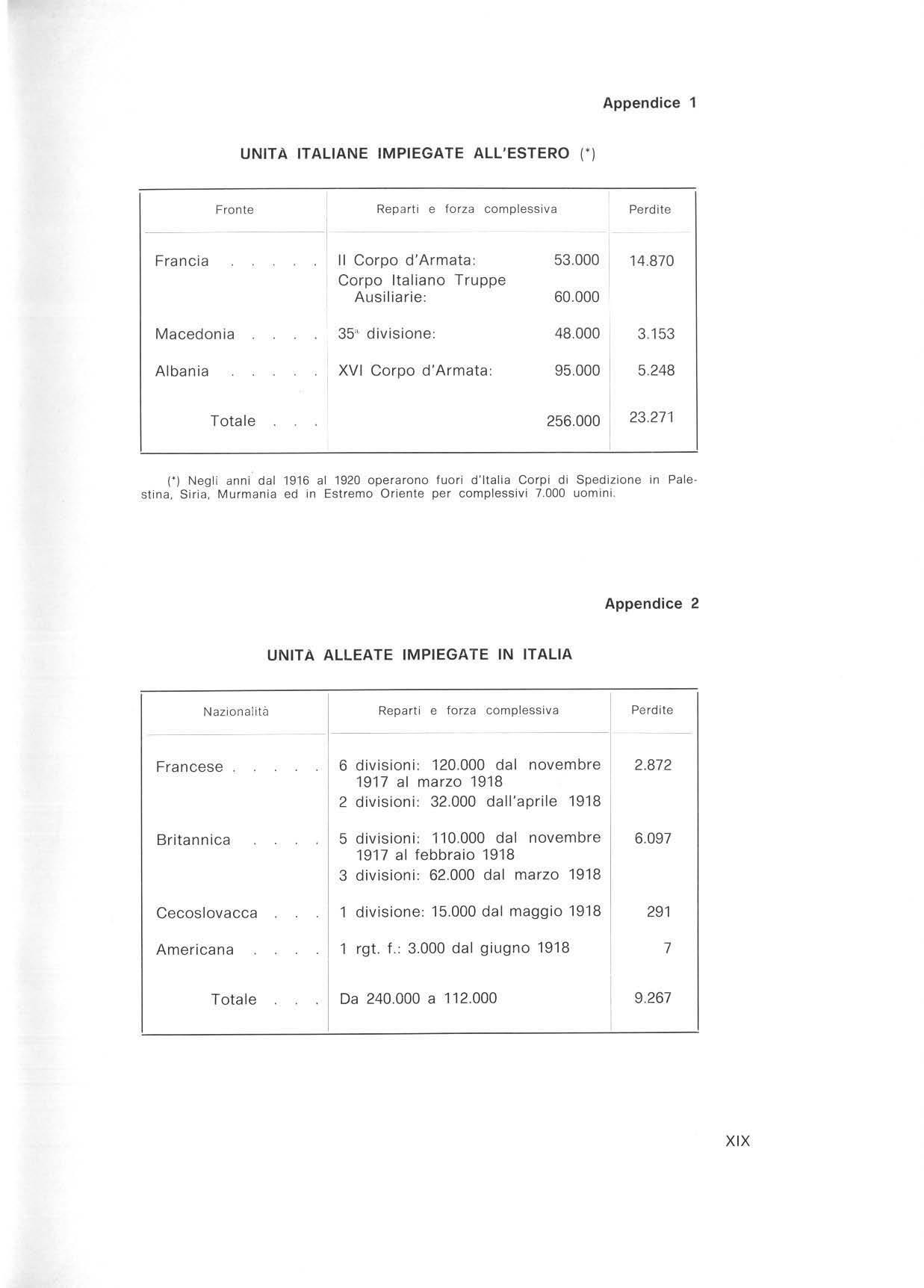
1 div isione: 15.000 da l maggio 1918
1 rgt. f : 3.000 dal giug n o 1918
Foreseeing the intervention in the war the ltal ian Chief of Staff, Generai Cadorna had given instructions to stand on the defensive in the Trentine front, while a thorough offensive should have been launched in the Julian front in the direction of Ljubljana and Zagreb, together w ith poss ible concurrent attacks from Cadore and Carnia.
This planning was apparently ambitious. but it was just ified by the main assumption that there would have been the support of the Serbian and Russian armies, the first from the low Sava toward Ljubljana and the second from the Carpathians toward the Hungarian plain.
Theretore the ltalian army, having a lready assembled (June 13th. 1915) 569 batta lions, 173 squadrons, 512 troops, was so deployed: 40 % to defend the border between Stelvio and Mt. Canin (560 Km) , 40 % in the Julian front (70 Km) and the remaining 20% kept in reserve .
In t he ltal i an front the Austro - Hungarian army was composed of 234 battalions, 21 squadrons and 155 troops. In addition there was the Bavarian « Alpenkorps », deployed in the Trentino area. although the war between ltaly and Germany was not yet formaly declared.
These troops, numerica ly inferior, had the advantage to fight from tortified positions. naturally strong and very well settled with field works

When lta ly began the war (May 24th, 1915) the above - mentioned p lanning was already unfeas ible. The Russians. hard defeated in Galicia, were compel l ed to such a dangerous and deep retreat. that th e Austrians could recover from that front some divisions, immediately dep l oyed in ltaly Strangely, by th e same time , the Serbians were completely inert.
Therefore, falling the in dispensable indirect support of the Allies, ltalian operat i ons had initially t he more limited aim of seizing good starting positions, suitable tor making easy further operational developments
However the first fights were not able to get the desired offensive outputs beyond the Isonzo, so inducing Generai Cadorna to choose tor the moment closer ob jectives as the acquisition of Gorizia and Tolm in o
As a matter of fact it was clear that also in ltaly, as tor months in France and in F l anders, the continuity of a front l in e saturateci w it h troops and a balance between the appos i te armies were i mposing a stat i c war.
The 23rd of June the f irst Isonzo battle began and the fighting lasted XX violent and relentless tor f i fteen days running
However, the attempt to conquer Tolmino fai l ed , while the enemy held out the Podgora efficaciously More to the south , the first bridgeheads were established beyond the Isonzo
This was the first very hard and bloody test tor the ltalian army: 15.000 losses .
After only a fift e en day truce, the 18th ot July, the battle starte d aga in all over the Isonzo This second battle was actually the prosecution ot the first one, with very heavy losses : 42 000 men, equal to those ot the Austro - Hungarians
From the 18th of October to the 4th of November and from the 10th of November to the 2nd of December th e third and th e fourth Isonzo battles took piace , aiming at the achievement of the middle part of the river
These operations, similar to those carried out in the French front , were decided by Cadorna to relieve the pressure of the Austro - Germans on the Russian and Serbian armies .
In almost two months of b l oody combats (116.000 wer e the ltalian losses and 70.000 those of the Austrians) the 2nd and 3rd Armies were able only to damage the enemy defensive system, with no break at all.
The 1916 large operations were six : the 5th Isonzo battle , fought in support of the French army engaged at Verdun; the Austrian offensiv e in Trentino and the following ltalian counteroffensive; the 6th, 7th. 8th , and 9th Isonzo battles
The Trentino and the 6th Isonzo battles , with the taking of Gorizia , were very important events
The decision to attack ltaly from th e Altipiani, in arder to go down to the Vicenza plain and catch in the rear the armies deployed in the Venetia Julia front. carried out an old pian of the austrian Chief of Staff , Marshal Conrad To perform this pian with a high chance of success the best Austrian troops were withdrawn from the eastern front, an opportunity immediately taken by Russia to attack the Austro - Germans and inflict a heavy defeat (Lutsk, June - July 1916) on them
The 15th of May two hundred Austro - Hungarian battalions hurled themse lves on the ltalian positions between Adige and Brenta.
Under the furious v i olence of the attack the defensive line bended, but it stiffened on backward pos i t i ons, so enabling Genera i Cadorna to declare that the Austrian offensive was stopped ali over the front.
The lta l ian troops took then the counteroffensive, driving back the Austrians well inside the Tridentine mountains.
lmmediately after the Trentino defensive victory, the 6th Isonzo batt l e began (4th - 17th of August). the Gor i zia battle, which cost serious lcsses, compensateci however by the seizure of positions regarded as s t ormproof: Calvario , Mt. San Michele, Sabotino and Gor i zia.
In the short course of two months, trom the 14th of September to the 4th of November, three battles in a row occ u red in order to wear out the enemy more and more and to seize suitable positions for outflanking Gorizia eastern hills from the south and the Hermada from the north.
The 1916 so ended without gett i ng any dec i sive result, so that everyth ing was defe r red to 1917. According to conc lusions of the 2nd Conterence XXI

of Chanti lly, held in November 1916, contemporary violent offensives should have been launched during this year all over the fronts of the Entente.
In May of 1917, in fact. wh ile the large spring offens ive was stili going on in Fra nce , the Sup r eme ltalian Headquarters decided to attack all along the Ison z o line.
The operation develop ed from 1he 12th to the 28th of May (10th Isonzo battle) leading to the ltalian conquest of Kuk and Vodic e
Subsequently , from the 10th to the 29th of June , the l ta lian army carried out the Ortigara batt l e in t he Altipiani sector without any positive result. but with very h e avy l osses (26.000 men) , mainly within the a lpine troops
A new offensive action (11th Isonzo batt l e) was dec ided right away, aiming simultaneously at the occupat i on of Bainsizza and Comen Plateaus
This offensive lasted from the 17th to the 31 st of August and got some results
The 2nd Army was able to penetrate tor about 8 Km in t o the Ba ins i zza Pl ateau, wit hout drivi n g complete l y out the Aust r ians
The 3rd Army , on the con t rary, got on ly very few successes , moving the front line only a little forward in the v i c inity of Hermada.
And th i s was the last l talian offensive battle in t he Isonzo front.
So the l ta lian army was wearing more and more and among the fighting troops the hope of getting rid ot the enemy rocky and iron barrier was weakening . The distrust. nourished also by neutra list trends never appeased with in the country, caused a natura l enfeeblement of moral courage with consequences on the discipl i ne
But a lso the enemy was ser i ously fee ling the weigh t of blows he had received, so that he was obliged to ask the allied Germany tor support.

The in activity in the French theatre, after t h e fai lure of the Nivelle offensive. and the a lmost total co llapse of t he Russian ar my al l owed seven German div i sions to crowd in ltaly , forming together with 8 Austrian divisions the 14th Army
At dawn of the 24th of October the 12th German divis i on, com ing out fr o m Tolmino, broke through the ltalian l ine and. going along th e Isonzo vailey. o n the back of the forward defe n ce. reac hed Caporetto at 3 p m Followi ng this div i sion , in the same d ay the German alpine troops seized ali the east ern region of Kolovrat. key point of the ltalian second l ine of defence.
The moveme n t of the f irst two German units was immediately fol l owed by 5 more divis i ons.
At nighttal l of the 24th of October t he right of both first and second l ines of defence was ou tfl anked. from To l m in o to f<olovrat, wh ile the center of the t h ird line was overco me at Caporetto.
The next day the A us t ro - Germans developed a large manoeuvre go ing beyond the Isonzo at Saga and push ing on as fa r as Mt. Maggiore.
In the n orthern s ide t he 10th Austr ian Army moved towards t h e Tag l iamento; in the c e ntre the troops fol l owi ng t he 12th German div i sion r eached t h e lateral r idge of Mt. Ma t aj u r from Caporetto; t h e left wing of attacking formations directed from Kolovrat to t h e roads of Cormo ns and Civ i dale
The 26th, the 14th Army , once al l the defensive mountain positions had been overcome , broke into the plain and directed to Cividale whi l e the 10th, to the north, reached t he Fella valley A l so Boroevic Army Group XXII started the offensive in t he Carso
At 2 a.m of the 27th of October the lta lian Supreme Headquarters ordered the generai retreat.
The river Tagliame nto was selected as the first line of resistance, but later on i t was recognised the need to retire as far as the Piave
The 9th of November all the remaining troops had reached the r i ght side of the river Piave. where part of th e army was already deployed to tace the enemy.
The Austrian Headquarters decided to pursue further on the offensive aiming at the tota! destruction of the ltal i an army
The defe n sive batt l e was conducted in two phases : from the 10th to the 26th of Novembe r and from the 4th to the 30th of December
In the first phase the Austro - Hungarians. attacklng along the river Piave . succeeded in penetrat ing into the bend of Zenson. pulling back the defensive line to the south of Musile, al ong Piave Vecch i a and Sile In spite of these loca l successes the offensive fai l ed and the 26th of November the Austro - Hunga r ian Headquarters ordered to stop the attack.
In the meanwhile other ltal i an divisions had been reorganized and. from the 4th to the 5th of December, French and British divis i ons reached the front line between Mt. Tomba and Montello .
The 4th of December the 11th Austro - Hungarian Army began the second phase with the successfu l attack and the conquest of Le Melette , but it was stopped on the line Co l d'Echele, Col del Rosso, Mt. Va lbella.
The 1 1th of December also the 14th Austro - Ge r man Army took to the offensive again on Mt. Grappa, but w i th very l imited successes.
Fig hti ng very hard , it was on ly ab l e t o set foot on Co l Della Berretta. Co l Caprile. Mt. Asolone, Mt. Spinoncia. A last offensive start the Christmas· battle, took piace in the Altip i ano.
The 25th of December the 3rd Austro - Hungarian Army Corps attacked and seized Mt. Valbella and Col d'Echele, but the defence conso l idateci along the li n e at the back. Cima Echar, Mt. Me l ago. Pizzo Razea
The hard battle ended with the first Austro - Hungarian failures : the 30th of December the 47th Frenc h division reconquered the ridgeline between Mt. Tomba and Monfenera and the 31st the lta lian troops eliminated in the bend of Zenson t he enemy penetration
Caporet to battle was u ndoubted l y tor the l talian army a pain f ul failu r e . but two circumstances s hould be pointed out :
- on l y the geograp h ica l course o f t h e lta lian border changed a tactica l failure in a strategie de f eat;
- Caporetto was to r t h e l ta lians only al" un l ucky event w h ich they struggled by themselves to rapidly overcome.
The ret reat at t h e rive r Piave, in fact. deliberately direc t ed by Ge n erai Cadorna with calmness and clearness (he was rep l aced by Gene rai Di az on t he 9 t h of Novembe r ). was a pu r ely l talian action as well as the fol l owi ng v i ctorious defence ba tt le.

O n ce t h i s ba tt le w as o v e r an d wh ile all t he co un try suppor t ed the Supreme Headquarters in carrying on the overa ll reorganization o f military s t ructu r es. the l talian army did no t stay inacti v e.
From the 28t h to the 30th of January a successful offensive operation o n the Altipia n o Dei Sette Comun i led t o reco nquer t he line M t. Va lbel l a. Col del Rosso, Pizzo Razea. A sim ilar co rr ec t ion of the co n tac t line was made in May, at M t. Adamello. XX II I
In March. when the large German offensive was launched in F ra nce, 4 French divisions out of 6 and 2 British out of 5 cou ld be withdrawn from the italian front without any problem .
With the offensive of autumn 1917 the Centrai Powers did not succeed in breaking down ltaly. Therefore, being time in favour of the Entente, they were loc king necessarily tor a rapid solution of the war by means of large strategie offensives.
This was the main reason of the Austrian offensive of June 1918
The operational pian foresaw: a main effort along the river Brenta , intended to break quickly through the mountain front, reach the plain and outflank the units engaged in the defence of the river Piave; contemporary an action of the Isonzo Army Group towards Treviso - Mestre, having as first objective the Bacchiglione line. Another attack to Tonale , together with divers ions to the Giud i carie and Val Lagarina, had to precede the other operations in order to fix l talian forces
Altogether Austro - Hungarian troops amounted to 60 divisions, 50 of which, from the Astico to the sea, ass igned to the attack and 7.500 artillery guns of ali calibers.
Against these forces the ltalian army set 56 intantry div isi ons (50 ltalian , 3 British, 2 French. 1 Czechoslovak), 19 of which in reserve, 3 cavalry divisions and 7.053 artillery guns .
At dawn of the 12th of June. a vio l ent artillery fire broke out. lt was the beginning of that demonstration to the west of the Astico , by which the enemy intended to fix ltalian torces
The efficacious counterpreparation fi re and the intense machinegun reaction immediately broke down every Austrian foolish ambit ion The diverting attack turned so into a clear failure

At 3 a.m of the 15th of June the Austro - Hungarian artillery began to bcmb the front from the Astico to the sea, but the ltalian counterpreparation f ire had a lready broken out with intens e violence.
In the mountain sector the attacks exhausted almost immed i ately, while in the area of the Piave the Austr i ans succeeded in going to the right s i de of the river, in spite of the strong ltalian reaction.
The attacking troops could get ho ld of the salient of Montello through the opened breach and establish on the right side of the river two bridge - heads, at Fagarè and Musile
Notwithstanding the desperate Austro - Hungarian efforts, the situation d id not change in the follow ing two days, either on the Altipiani or between Brenta and Piave; on the l ow Piave a powerful Austrian attack was able to join the two bridge - heads at Ponte di Piave and S Donà, but it d id not succeed in advancing further on.
The reiterated and obstinate attacks of the Austro - Hungarian divis i ons were only cutting down their forces more and more In the even in g of the 17th. the pressure of the attacking troops was stopped everywhere. In t he followi ng days, the fina l deteat of the Austrian troops was evident: during the n ight to the 23rd ot June, they began retreating beyond the river Piave .
The river Pi ave battle. which cost the Austr i ans 150.000 men, was XXIV a great ltalian victory, the first achieved in 1918 by an army of the Entente .
During the summer Generai Foch renewed to Generai Diaz more than once th e request to carry out an offensive . Diaz temporized because it was right to wait for the appropriate moment to engage a decisive battle
Sinc e mid July the German Supreme Headquarters had Jost the initiativ e in th e French theatr e and its army was f orced to withdraw , without losing however its unity
From the 16th to the 19th of September the « Armée d'Orient » caused the German - Bulgarian front in the Balkans to collaps e and the 29th of September the armistice between the Allies and Bulgaria was signed
The lta lian Supreme Headquarters saw then the possibility to break through the enemy front along the connection line between the two Austrian armies (5th and 6th) of the river Piave , moving then towards Vittorio Veneto
This operation had to start on the 16th of October but it was deferred to the 24th in consequence of the flood of the river
The 4th · Army began the battle and pro l onged its attack up to the 27th , reaching the aim of recalling and taking up Austrian reserves.
During the night to the 27th ltalian armies (8th, 12th and 10th) bridged and crossed the river Pi ave
On the 28th the violence of the attack ob liged the Austro - Hungarian 6th Army ' s Headquarters to command the retreat to Monticano
On the 30th, the 8th Army took possession of Vittorio Veneto with the vanguards ; th e 12th Army got aver the pass of Ouero towards Feltre ; the 10th crossed the Monticano in direction of Sacile
In the evening of the same day, Austrian Generai Weber presented himself to our Supreme Headquarters to discuss the terms of surrender
The negotiations were not however so fast be cause the Austrian Governement did not want to sign an unconditional surrender but only a truce in the combat.

During these discussions operations went on and on the 31st the Austrian troops of Mt Grappa yielded fina lly to the violence of the 4th Army's attack which moved then to Arsiè; the 8th Army broke into the Piave valley at Ponte delle Alp i ; the 10th , together with the 3rd, reached the river Livenza and the cavalry the river Tagliamento ; the 6th army moved also along the Valsugana , to get the road towards Trento - Egna
On the 3rd to November the 1st Army was in Trento, al i the other Armies reached their objectives and, w h ile the cavalry pushed on as far as Palmanova Udine and Stazione per la Carnia. a specia l detachment l anded at Trieste .
In the even ing of the 3rd of November the armistice was finally signed in Vi lla Giusti : at 3 p m of the 4th of November 1918 hosti lities were suspended all aver the ltalian front.
Pushed by an age - o l d hate, staunch discipl ine and military honour se nse, the imper i al army fought ve ry bravely even in the l ast battle, so that losses were serious : 36.498 ltalians and 2.498 tor the Allies
With the battle of V ittorio Veneto ltaly did not defeat on ly « one of the most powerfull armies in the world ». but caused the tota I collapse o f the Hapsburg Empire
The effort was enormous - 5 millions men mobi lized, 900.000 militarized in the war industry, 680 .000 fa llen . more than one mi llion wounded XXV
and cr ippled - but the historical cycle of the italian Risorgimento was finally aver with the reaching of natural borders .
The contribut i on to the common victory given by ltaly out of the country must be mentioned to provide an overall picture of the war situation.

In Albania, after the outbreak of the war, ltaly took possession of the small island of Saseno and then (December 29th, 1914) of Valona, as a protection of ltalian interests in the Adriatic sea.
On the 8th of October 1915 the Austro - Germans, supported by the Bulgarians, began the decisive offensive against the Serbians .
The landing at Salonika of a first Franco - British unit dici not help the withdrawal of the Serbians, who had to f ind safety in the Albanian ports.
ltaly then took upon herse l f the protection of the withdrawal and embarking of the remnants of Serbian army.
A special Corps of occupation of A lbania was organized, with a division tailored in three brigades, one of which had to move to Durazzo. while the other two would have assured the possession of Valona.
The brigade << Savona » reached then Durazzo, where it settled down the defence to protect the embarcatio n of the Serbians, compieteci by the 9th of February 1916; the brigade kept the Austrians far two more weeks, before embarking under the protection of the f l eet, from the 23rd to 26th. Valona bay was still in the italian hands.
Troops in Albania were gradually increased, reaching the level of an Army Corps (XVI) of about 100.000 men, tailored in three divis i ons
In the meanwhile the allied expeditionary torce of Salonika (Eastern Army} pushed on towards west. ltalian troops of Albania carne in contact with that torce at Erseke, so estab lish ing a continous front from the Adriatic sea to the Aegean.
In May 1918 a comb ined French and ltalian operation on the right of Ossum and towards Tomoritza succeeded in making safer the road Erseke - Salonika and, in July, an ltalian attack, supported on the right by French forces, was carried on against the two wings of Malakastra
At the end of September, in connection with Eastern Army offensive the XVI Army Corps took to the advance again, reaching Durazzo on the 14th of October, Tirana on the 15th, Scutari on the 31st and, finally, Dulcigno and Antivari on the 3rd of November.
At the end of 1915 the 35th Eastern Army was organized and the ltalian Governement was asked by the Allies to send troops to Macedonia.
On the 9th of August 1916 the 35th division began to embark at Taranto, to be deployed the 25th of August along the line Krusa - Balcan, on a 48 Km front.
In September of the same year the division took part in a counteroffensive operation; then it was removed to the Monast ir (Bitola) sector where on the 16th of November it opened the way to the Franco - Serbian troops toward Monastir.
At the begining of 1918, the 35th division went to the Crna sector, XXVI replacing in the front two French and one Serbian divisions.
After eight German attacks in two months there was in May an Allied offensive attempt : it was not successful and only the ltalian losses were about 3.000 men.
On the 15th of September the Eastern Army took the offensive and broke throught the enemy front.
The 35th division drove the Germans out of Kalabach mountains. reached Kruscevo across the Baba Planina and the 29th attacked Sop, where 8.000 Bulgarians and 11 guns fell into our hands
In November 1917 the ltalian Governement sent to Paris Generai Dal lolio to negotiate the transfer of war materiai. The French Governement agreed asking however as a compensation the sending of 10 .000 ltalian workers to be assigned to artillery ammunition loading
Afterwards the French Governement asked far other 60.000 men. as workers in the defensive forti fications. In January 1918 these workers left tor France . so originating the T.A.I.F. (Auxiliary ltalian Troops in France)
In Aprii the Il Army Corps (two infantry divisions with minor units) was sent to France.
From the 11th to the 19th of June the Il Army Corps drew up west of Reims to bar the straightest penetrating way to Epernay.
From the end of June to early July first encounters with the Germans took piace in the zone of Bl igny. On the 15th of July the Germa n s launched their fast offensive, attacking west of Reims between Vrigny and Jaulgonne against the ltalian Il Corps and the V French Corps
At the end of this operation. where the Il Corps l ost more than 9.000 men, the 5th French Army's Commander, Genera i Berthelot wrote : « (the ltalian Army Corps) completed successfully its missions. barring to the enemy the way of the Ardre »
In August the Il Corps was sent to the Argonne but in September it was back again under the 5th French Army in the offensive against the salient of Laon lt was drawn up in the Aisne sector, east of Soissons
On the 26th of September the Allied offensive began and on the 14th of October the Il l ta lian Army Corps, co nquering the strong position of Chemin des Dames and getting aver Ailette. reached the Sissonne marsh
On the 4th of November the Il Corps began again to advance against the Germans. reaching the river Mosa by the 11th of November
During the war the Nations of the Entente attained a community of ideals and ends that originated. as we saw , a real military brotherhood lt is then a fair conclusion to this historical synthesis of events to report In two append i xes the l ta l ian losse s on t he various f r onts of the Entente and those of the Allied armies in ltaly

· 1 6 divisions (from November 1917 to March 1918) : 120.000
2 divisions (from Aprii 1918): 32.000
British 5 divisions (from November 1917 to February 1918): 110.000
3 divisions (from March 1918): 62.000
Czechoslovak 1 div ision: 15.000 (from May 1918)

En prévision de l'entrée en guerre, le Chef d'Etat - Major italien , Généra l Cadorna, avait établi: défensive sur le front trentin; offensive sur le front julien vers Laybach et Zagreb ; de possibles offensives concourantes du Cadore et de la Carnia .
Le pian , apparemment ambitieux , se basait surtout sur le concours de l'armée de terre serbe de la basse Save vers Laybach et de l'armée russe depuis les Karpathes vers l a plaine hongroise .
Par conséquence l'armée de terre qui , une fois rassemblée (le 13 juin 1915) comprenait 569 bataillons. 173 escadrons, 512 batteries, fut deployée par deux - cinquièmes à barrage des 560 Km de frontière entre le Stelvio et le Mont Canin, par deux - cinquièmes sur le front jul ien (70 Km) tandis que un - cinquième fut tenu en réserve.
L'armée de terre austro - hongroise, réso lue à garder, pour l'i nstan t. une attitude défensive , totalisait 234 batai llons, 21 escadrons, 155 batteries; encore faut - il ajouter l'Alpenkorps bavarois qui était déployé dans l e Trentin, bien que officiellement l'ltalie et l 'A llemagne ne fussent pas e ncore en état de guerre
Les forces austro - hongroises, numériquement moins nombreuses, avaient l'avantage de combattre sur des positions fortes au point de vue du terrain et bien organisées grace à des travaux de fortifications

La première année de guerre .
Lorsque l'ltalie entra en guerre (le 24 mai 1915) l e pian n'était plus réalisable. Les Russes, battus en Ga lic i e, étaient contraints à un rep li dangereux et l ong - si b i en que les Autrichiens f urent en mesure de rappeler de ce front que lques d ivisions qu i, tout de suite après, furent rangées en ltalie - et l es Serbes étaient tombés dans un stade d'une drole d'inert ie.
De cette façon n'ayant p lus l'indispensable appui indirect des A l liés , l es opérations initiales ita liennes eurent le but plus raisonnable d'occuper de bonnes positions de départ , aptes à facil iter les ultérieurs dével oppements opérati f s.
Les combats initiaux n'atteignirent guère l es souhaitables débouchés offensifs au delà de l' Isonzo; c'est pourquo i le Général Cadorna replia sur des objectifs plus limités , en se proposant à ce moment - l à la conquéte de Goritz et de Tolmino
Il éta i t év i dent, en effet, que en l talie comme d'ailleurs depuis p lusieurs mois en France et dans les Flandres, l a cont inuité du front. comb l é XXIX
de troupes , et l'équilibre entre les forces opposées. imposaient la guerre de position .
La 1'" bataille de l'Isonzo fut déclenchée le 23 juin . Le combat se prolongea violent et acharné pendant 15 jours. mais les efforts pour gagner Tolmino ne reussirent pas et sur le Podgora l'ennemi tint efficacement. Au sud on impianta les premières tetes de pont au delà d e l'Isonzo .
Voilà la première épreuve très dure et sanglante pour l 'armée de terre italienne: 15 000 morts
Onze jours après seulement, le 18 juillet, la bataille recommenca le long de l'Isonzo.
En principe cette deuxième bataille était la continuation de la précédente
Le bilan de l'action comporta peu de gains et nombreuses pertes : 42 000 hommes. De meme pour les Austro - Hongrois
La 3" et 4• bataille de l'Isonzo. qui visaient à la conquete du cours moyen de l'Isonzo, se deroulèrent du 18 octobre au 4 novembre et du 1O novembre au 2 décembre.
Ces opérations, analogues aux actions entreprises sur le front francais, furent decidées par l e Général Cadorna dans le but d ' alléger la pression exércée par les Austro - Allemands sur l'armée de terre russe et serbe
Après un mois et demi de combats sanglants (bilan de pertes : 116.000 ltaliens et 70.000 Autrichiens) la 2" et la 3" Armée reussirent à pénétrer quelque part dans l'organisation défensive adversaire, mais sOrement pas à la briser
le s années 1916 et 1917.
Les grandes opérations du 1916 furent six: la 5" bataille de l' Isonzo , combattue pour aider les Francais qui étaient engagés à Verdun ; !' offensive autrichienne au Trentin et la conséquente controffensive italienne ; la 6", 7'', 8· et 9" bataille de l'Isonzo
Les p lus importantes entre e lles furent la bataille du Trentin et la 6'' bataille de l'Isonzo qui aboutit à la conquete de Goritz.
La décision d'attaquer l'ltalie par les Plateaux , pour descendre dans la p l aine de Vicence et attaquer par derrière les armées rangées sur le front de la Vénétie Julienne, réa lisait un vieux pro jet du Chef d'Etat Ma jor autrichien. le Maréchal Conrad. Pour le réaliser avec plus de probabilités de succès. les meilleures unités autrichiennes furent rappelées du front orientai. La Russie, d'ail l eurs, en profita tout de suite pour attaquer les Austro -A llemands et leur infliger une défaite écrasante (Lutsk. juinj uillet 1916)
Le 15 mai 200 bata il l ons austro - hongrois déferlèrent sur les positions italiennes qui se trouvaient entre l'Adige et le Brenta.
A cause de l'impetuosité de l'attaque, la ligne défensive eut une f l ex ion , mais el l e se rétablit sur des positions plus en arrière et le 3 juin le Maréchal Cadorna pouvait annoncer que !'offensive autrichienne avait été stoppée le long de tout le front. En conséquence de la controffensive ita lienne, les Autrichiens furent à nouveau refoulés dans la zone montaXXX gneuse du Trentin
